







































The 32nd Aapresid Congress, under the motto "Everything is connected", was held in the Autonomous City of Buenos Aires for the first time in history, specifically at the Predio de La Rural in Palermo.
The past 7, 8 and 9 of August showcased Aapresid's dedication, a growing institution that provides knowledge and seeks to be part of the progress and evolution of Argentine agriculture.
One year in advance, we began to work on how we wanted this important event for the institution to be, and that had the extra challenge
of moving headquarters. We pondered the message we wanted to convey, which is why the motto "Everything is connected" was not just a phrase but a message in which we all got involved, ensuring it was reflected in every moment of the Congress.
We worked very hard on the content, organizing co-creation workshops for each sub-axis of the event, inviting not only actors of the agricultural sector but also those not related to agricultural activities. We sought a broader and more diverse outlook, which enabled us to build the content for the congress. This is where I want to stop to thank everyone who participated in the process; they were crucial and very important in setting up everything that was developed.
The 32nd Aapresid Congress once again exhibited a great wealth of knowledge through many distinguished speakers, both domestic and international. More than 160 companies were present in the commercial hall, and we also thank them all for their support. The participation of numerous institutions was also essential for the development of the congress due to their valuable contributions.
One of the fundamental pillars of this event is the public, and we appreciate their attendance once more: together we accomplish a great congress.
There is a challenge ahead of us, to keep on building the Aapresid Congress as a space to meet, to encourage ourselves to keep on learning from different points of view, and to help us generate new bonds to achieve better agriculture, involving everyone from a collaborative perspective.
Every congress represents a challenge, and the path toward it is very enriching and full of learning. For all of this, besides thanking you all, I invite you to keep on working together. "Everything is connected" has had its place, and now, the challenge is to stay connected and progress toward continuous evolution.
Paola Díaz Deputy Director of Prospective Program




RESPONSIBLE EDITOR
President of Aapresid
Marcelo Torres
DEPUTY DIRECTOR OF PROSPECTIVA
Paola Díaz
EXECUTIVE EDITOR
Rodrigo Rosso
WRITING AND EDITING
Antonella Fiore
CONTENT MANAGEMENT
María Eugenia Magnelli
PROOFREADING AND EDITING
Lucía Cuffia
TRANSLATION
Laura Cudugnello
LAYOUT AND DESIGN
Daiana Fiorenza
Chiara Scola
COORDINATING MANAGER
Tomás Coyos
PROSPECTIVE PROGRAM
Rodrigo Rosso
Antonella Fiore
Lucía Morasso
Delfina Petrocelli
Sofía Colalongo
NEXUS
Matías Troiano
Dorrego 1639 Piso 2 Of. A Tel. 0341 426 0745/46 aapresid@aapresid.org.ar www.aapresid.org.ar
ASSISTANT DEPUTY DIRECTOR
Carolina Meiller
Alejandro Fresneda
Carla Biasutti
Elisabeth Pereyra
COMMUNICATION
Florencia Novau
Matilde Gobbo
Florencia Cappiello
Elina Ribot
Magalí Asencio
Agustina Vacchina
Delfina Sanchez
CHACRAS SYSTEM
Andrés Madias
Suyai Almirón
Magalí Gutierrez
Lina Bosaz
Ramiro Garfagnoli
Solene Mirá
PEST MANAGEMENT NETWORK
Eugenia Niccia
Juan Cruz Tibaldi
Matías D´ortona
AAPRESID REGIONALS
Virginia Cerantola
Bruno De Marco
Joel Oene
INTERNATIONAL PROGRAM
Mailén Saluzzio
Federico Ulrich
AAPRESID CERTIFICATIONS
Juan Pablo Costa
Rocío Belda
Eugenia Moreno
Myrna Masiá Rajkin
ADMINISTRATION AND FINANCE
Cristian Verna
Vanesa Távara
Dana Camelis
María Laura Torrisi
Mariana López
Daniela Moscatello
Samanta Salleras
Julieta Voltattorni
PERSONNEL MANAGEMENT
Macarena Vallejos
STRATEGIC PROJECTS
María Florencia Accame
María Florencia Moresco
SECRETARY
Karen Crumenauers
As a balance between productivity and sustainability, the challenges, opportunities, and necessary strategies were assessed to move toward a more responsible and fair agricultural future.
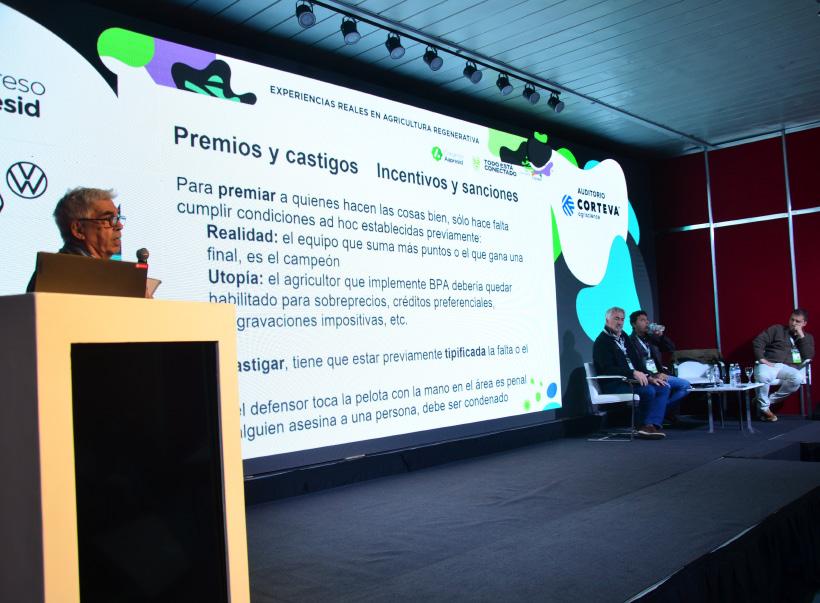
During the 32nd edition of the Aapresid Congress, "Everything is connected", Alejandro Cuadra, director of Cuaeco SAS, Diego Fontenla, from Grupo Pampa Orgánica Sur, and Jorge Adámoli, ecologist and environmental consultant, shared their experiences in the search for sustainability within the framework of the "Regenerative Agriculture and Agroecology" axis.
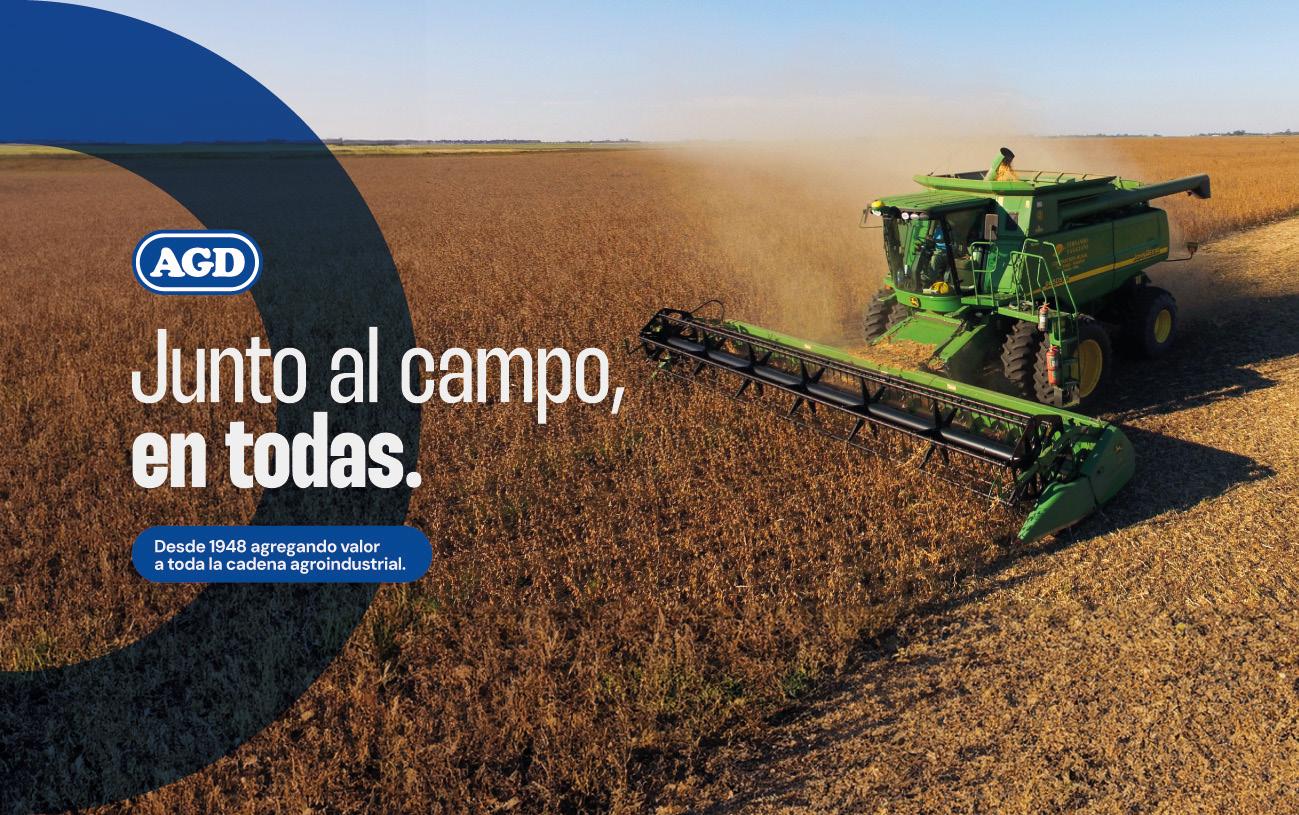
Good Agricultural Practices: how to move from good intentions to action
In accordance with the United Nations’ goal of increasing food production by 50%, the specialist Jorge Adámoli said: "We need to move from good intentions to solid actions." Good Agricultural Practices (GAPs), besides producing food, also increase biodiversity and enhance soils and climate. Although there is real awareness of the importance of their adoption, the high tax burden, which affects 65% of agricultural output, makes their implementation difficult.
To address the need for improving the relationship between the agricultural sector and society, Adámoli compared bad agricultural practices to soccer rioters, highlighting that they should be eradicated. To achieve significant progress, one option is to develop a system of incentives and penalties. "Farmers adopting GAPs should receive benefits such as price premiums, preferential credits, and tax exemption," the specialist proposed. Regarding penalties, he emphasized the importance in
“Farmers adopting GAPs should receive benefits such as price premiums, preferential credits, and tax exemption.”
clearly typifying faults and failures. In Argentina, with a few exceptions of special laws like fauna conservation, penalties are commonly civil.
Adámoli also spoke about the new European Union regulation on deforestation, describing it as "a para-tariff measure disguised as environmental concern." According to the specialist, this regulation does not distinguish between legal and illegal deforestation, which transgresses local regulations. Argentina conserves 70% of its natural environments in the Chaco region, widely exceeding the suggested 15% by the International Union for Conservation of Nature to preserve biodiversity. As regards the
fight against climate change, Adámoli said that G20 country members are responsible for 75-80% of global emissions, while Argentina emits only 0.59%, and agriculture represents a tiny fraction of this number.

Finally, to transform public perception, Adámoli emphasized the importance of strengthening the existing GAP network–with more than 90 entities–and acting politically alongside key actors, avoiding unnecessary bureaucracies, and valuing the environmental services provided by the sector.
Alejandro Cuadra, advisor and farmer in the NOA region, conveyed his experience in employing regenerative agriculture, oriented toward transitioning from conventional agriculture to agroecology. The main goal is to restore the soil’s physical, chemical, and biological health, together with biodiversity and environmental balance.
Cuadro advised avoiding abrupt changes: "Trying to move from conventional production to agroecological production overnight is the main cause of failures," he said, and suggested starting with only 20% of the field's surface
Therefore, planning and diagnosing every situation is essential. It is crucial to monitor each environment and conduct an economic analysis suitable for every action taken. One of the primary challenges in the region, covering Santiago del Estero to Salta provinces, passing through
Tucumán, is climatic variability. Precipitation, generally ranging from 500 and 800 mm yearly, has reached as low as 300 mm in recent years, adding complexity to agricultural management.
One of the main regenerative practices employed by Cuadra is no-till farming, which is essential to maintain soil health. Additionally, he employs cover crop mixtures, leveraging biological nitrogen fixation through crops like vicia and crotalaria, and the use of natural decompactors such as radishes (Image 1). Cuadro also incorporates crops with allelopathic properties, such as oat and rye, to help control weeds.


Similarly, Cuadra said that the use of mixed cropping surpasses monocropping. For instance, he mentioned a corn and brachiaria mixture (Image 2): "When we mix crops, they synergize, and everything we accomplish in terms of restoration is greater than if they were alone."
The employment of these practices also increases water infiltration in the soil up to five times, which, during seasons with limited precipitation, can mark

"This type of production is distinguished by the non-use of chemical synthesis products."
Organic production: the plus of certification
Diego Fontenla, who has 30 years of expertise in the organic sector in the south of Buenos Aires, said that "this type of production is distinguished by the non-use of chemical synthesis products." Instead, practices like crop and livestock rotations are employed to maintain soil fertility and manage pests in the most natural manner.


Although many farmers can employ agroecological, biodynamic, natural agriculture, permaculture, or regenerative methods, when it comes to certification, SENASA labels their products as organic within a legal framework, giving them solidity. Organic certification becomes a crucial tool to stand out in the market and capture better prices. In an increasingly competitive setting, this certification enables farmers to access niche markets valuing the quality and sustainability of products. As a
result, farmers can obtain better prices for their products, as well as access to export markets, where demand is constantly growing.
Globally, the number of certified farmers rises 25% annually, and Argentina is placed third with almost 5 million certified hectares. Year after year, the country's agricultural surface expands and the whole institutional organization enhances and supports this growth.
Agriculture is at a critical point, where the pressure to increase food production is facing the need to do so in a sustainable manner. Regenerative agriculture, organic certification, and Good Agricultural Practices prove that there are multiple paths to achieve this balance.

Distinguished Argentinian researchers and technicians shared recent studies on bioindicators and their capability to assess the impact of our practices on soils and crops.

The thematic axis "Regenerative agriculture and agrotechnology" convened Gustavo Martos, a researcher at CONICET, Agr. Engr. Martín Zamora from Chacra Experimental Integrada de Barrow, and Agr. Engr. Santiago Lorenzatti from Okandu SA. They analyzed the current challenges of agroecological systems, the available means to confront them, and practical applications that can improve our agricultural management within a sustainable framework, maximizing their value.
Within the global context, Gustavo Martos noticed the drastic change in soil use over the past decades, and the expansion of agricultural land frontiers toward the most vulnerable areas. He also mentioned the challenge of producing more and better food sustainably in a setting of global agricultural intensification. The question arising from this apparent dilemma is, "How do we accomplish this?" Martos explained that a first approach to address this concern is through the use of sustainability indicators, which measure the impact of our action on the soil and crops. "What can be measured, can be improved," he claimed.

As the soil is the ecosystem's largest carbon sink, the researcher from CONICET said: "Little changes in soil carbon incoming (organic matter) and outgoing flows (CO2) have a great impact on global environmental processes." Under this premise, he delivered convincing conclusions from a study where different soil bioindicators assessed its health condition.
The research was conducted in Northwest Argentina. As a reference on the original functioning of the system in nature, they compared a native forest with conventional crop management (with monocropping interruption) and another sustainable one (with cover crop rotations). The results showed that basal respiration and microbial biomass in the native forest (M) tripled the observed values in conventional management (CM),
while sustainable management (MS) surpasses conventional by 25%. According to Martos, the mechanisms controlling microbial respiration are responsible for soil organic matter stabilization, and around 60% of carbon in agricultural soils (015 cm depth) is made of microorganisms’ residue.
The researcher emphasized basal respiration measurements (soil samples that emit CO2) and substrate-induced respiration (soil samples that emit CO2 by glucose addition) as crucial indicators of microbial activity. As shown in Figure 1, the lack of response before glucose addition indicates stress symptoms in the soil. "The incorporation of cover crops into the system is a great method for increasing basal respiration and, consequently, improving soil health," Martos said.

Figure 1. Basal and induced respiration in two production systems.
Adding to the subject, Martín Zamora presented the agroecological farm La Aurora, in Benito Juárez, Buenos Aires Province. This establishment has been working without plant protection products for 35 years, employing polyculture or cover crops aimed at promoting biodiversity of plants, flowers, and roots, as well as leaf architecture to improve light interception. Moreover, they add animals at strategic times and in an integrated manner to increase the recycling of everything that is being produced, and these animals are associated with different microorganisms and arthropods.

"In light of this description, the first things that come to mind are weed, insect, and disease problems, but within an agroecological system, no species dominates over another. If this were to happen, they could become pests. It could also be assumed that yields are low, but the results are astounding," Zamora said.
After several years, productivity, economic, and environmental indicators were assessed, comparing the results with a current production system–no-till farming, with crop rotation, fertilizer application, plant protection usage, and, occasionally, cover crops.
As regards results, both physical (porosity) and chemical properties (P-Bray, total nitrogen, soil organic carbon) in the soil, as well as enzymatic and microbial edaphic activity, and other indicators, were greater in agroecological systems. Current production management exhibited higher metabolic rate, indicating that microbial communities were less efficient in the use of C, which was wasted as CO2. "After six years, the agroecological system increased organic matter levels by 1%," the engineer said.
“After six years, the agroecological system increased organic matter levels by 1%.”
Moreover, regenerative agriculture, microbial communities, flora, and fauna, showed greater richness (more species), diversity (larger quantities of each species), and stability (Figure 2). From an energy point of view, the agroecological system doubles the efficiency of current management due to a lower use of supplies and machinery: per every unit of energy, 7.6 MJ/ha of food is produced under agroecological management vs 3.51 MJ/ha under current management.
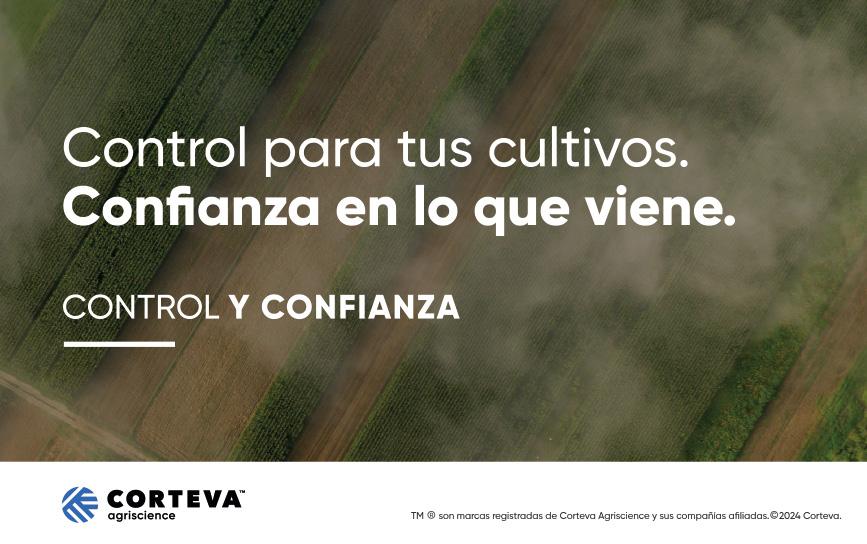

Figure 2. Arthropod collection and biodiversity assessment. The comparison between the agroecological farm La Aurora and a current management system (adjacent field).
Regarding GHG emissions, a study conducted on malting barley in agreement with Maltería y Cervecería Quilmes revealed that regenerative agriculture emits 60% less GHG compared to conventional agriculture (218 tones of CO2/ha vs 359). This proves that agroecological farmers are removing CO2 from the atmosphere.
Reinforcing prior concepts, Santiago Lorenzatti traced the evolution of the sustainability concept up to the current paradigm of rural sector multifunctionality and the sum of indicators to measure these ‘functions’.
Focusing on the edaphic quality, understood as the soil’s capability to function in an ecosystem, sustain biological productivity, maintain environmental quality, and promote the health of animals and plants, Lorenzatti said that this parameter is essential to ensure a profitable and environmentally sustainable agricultural production system.
For a soil quality indicator to be considered as such, the specialist specified that it should be based on scientific knowledge, be a quantitative expression that enables the location of a problem in relation to its critical threshold, and integrate physical, chemical, and biological edaphic properties for the interpretation of complex processes. Moreover, for these parameters to be useful, they should reflect recent changes in their management (sensitivity), be easy to measure and

soil's evolution and health, providing certainty on the impact of agricultural management and promoting a more professional management based on measurements," added Okandu's representative. On the same line, he emphasized the large body of scientific evidence connecting Good Agricultural Practices (GAPs) with desirable indicator values and mentioned Aapresid certified agriculture and its evolution toward a certified sustainable agriculture (ASC in Spanish) as examples integrating these aspects (Figure 3).






Figure 3. Good Agricultural Practices indicators. Certified sustainable agriculture.
Indicators are key tools to measure agroecological traceability, submit to a voluntary social audit, and certify products and processes.
Apart from indicators listed in Figure 3, there are those related to Environmental Practices such as water quality, soil organic carbon, water content in soil, water use efficiency, environmentally sensitive areas, and kilograms of used and recycled plastic. Additionally, there are Biological indicators (enzymes, fat acid profiles of total lipids, DNA, aggregates, fauna, etc.), and Economic and Social indicators (training, education, contribution, and interaction with society).
Besides improving the professional management of farming systems, indicators are key tools to measure agroecological traceability, submit to a voluntary social audit, and certify products and processes. The latter, in turn, enables the creation of brands or denominations of origin, providing products with additional, current or potential, commercial value.

Digital innovation ecosystems for optimizing agrifood systems. The value of local development and perspectives on international collaboration.

Within the framework of the Congress, Aapresid, alongside the Inter-American Institute for Cooperation on Agriculture (IICA), led a special section titled "Agrifood systems in the Americas: future perspectives and opportunities for the farmer". This section consisted of four first-class panels debating challenges, opportunities, and strategies for the sustainable development and global positioning of the American continent’s farming sector.



One of the panels addressed a crucial theme for the transformation of agrifood systems: what they are, how they are formed, and the role of digital innovation ecosystems. Experts from different parts of the world shared solid experiences of those ecosystems considered successful. The panelists included Laurens Klerkx, professor at the University of Talca (Chile) and Wageningen University (the Netherlands); Stephanie Regagnon, executive director of Innovation Partnerships at Danforth Center; Daniel Werner, head of Foreign Relations & International Cooperation Department at the Ministry of Agriculture of Israel; Mark Jarman, consultant at AgriTierra; and Federico Bert, coordinator of Digitalization of Agrifood Systems at IICA.
The agrifood system is facing complex challenges. On the one hand, the FAO foresees that approximately 25 years from now, the global population will exceed 9 billion inhabitants, demanding a significant increase in food production and distribution to ensure food security. Additionally, as markets become increasingly demanding, more food needs to be produced not only in terms of quantity but also quality. On the other hand, the context of climate change requires the agrifood sector to assume environmental responsibility to mitigate its impact, reduce greenhouse gas (GHG) emissions, and ensure sustainability.

At this juncture, efforts to transform agrifood systems to operate within planetary limits are increasing. Digital innovation ecosystems play a key role in channeling and boosting these efforts. According to Laurens Klerkx, these ecosystems are made up of "a multidisciplinary group of collaborative, public and private actors interacting dynamically to promote and facilitate the innovation and optimization of agrifood product production, management, and distribution."



Among the actors involved in these ecosystems are R&D centers, academic institutions, investors, and farmers themselves (Figure 1). Klerkx particularly emphasized the role of startups: "Innovation can emerge from agricultural research, big companies, or farmers themselves, but there is a group that has gained relevance, AgriFoodTech startups, which are proposing novel solutions with cutting-edge technology and biotechnology 4.0.” However, he warned not to be misled by successful cases from so-called 'unicorns' with individual achievements, as "these ecosystems entail collective, public-private work, supporting the startup and their customers in adapting and employing their innovative proposals."
Regarding successful cases, some innovations are distinguished in several areas, such as the creation of software and platforms to analyze and assess big data, and the development of geospatial and AgriTech technologies, especially precision agriculture. One notable example is the Israeli agrifood ecosystem presented by Daniel Werner, head of Foreign Relations & International Cooperation Department at the Ministry of Agriculture of Israel. This system faces typical challenges similar to other regions but also deals
with distinctive features, like an arid to semiarid climate and limitations in essential resources, such as water and productive lands. According to Werner, it is an interesting case because "this ecosystem
Creemos que para mejorar la agricultura hay que innovar. Por eso, hace 48 años investigamos para desarrollar tecnologías que sean la máxima expresión de la naturaleza.



less through the development of greater-scale machinery, speed, and productivity, as well as the improvement of seeds, irrigation, and fertilizers."
He mentioned four essential aspects:
1 Progress in agriculture 4.0: a group of technologies centered on the digitalization of agricultural processes.
2 Multidisciplinary approach and strong funding.
3 Active involvement of society and the early adoption of technology by farmers.
4 A network of actors interacting as facilitators of the innovation process.
The latter entails a succession of elements ranging from socio-cultural and educational aspects (pre-academic and academic studies promoting

an innovative vocation in people and highly qualified human resources) to a strong private sector (including venture capital). Moreover, governmental support is also important, such as financing incubators and innovation projects, along with a solid rural extension service that connects the private sector with academia and promotes the early adoption of new technologies (Figure 2).
Another aspect to consider is the scale or reach of ecosystems. Stephanie Regagnon said that "to unlock all the innovation the world needs in terms of environment and agrifood security, the solely functioning of the ecosystem in a certain region is not enough, nor for different local actors to assume a collaborative role. On the contrary, collaboration at both domestic and international level is necessary."
Therefore, it is interesting to consider Argentina’s opportunities to be part of the technological transition, given its experience in food production and agricultural technology development. Similarly, Werner emphasized the cooperation potential between the ecosystems of Israel and Argentina: "The vast amount of data generated due to agricultural digitalization should be exploited, developing big data platforms to make the most of the multiple existing initiatives in Argentina and Israel's broad experience in this field."
Ultimately, digital innovation ecosystems are leading the transformation of conventional agricultural practices, aiming to reduce costs, raise profitability, diminish environmental impact, and ensure productive sustainability. Nowadays, innovation enables the agricultural sector to be very competitive, and it will continue to be the driving force of the process in an increasingly complex environment.


Figure 1. Roles of relevant actors in agrifood systems in promoting digital transformation, according to Laurens Klerkx, professor at the University of Talca (Chile) and the Wageningen University (the Netherlands).

Figure 2. Chronology of facilitators, according to Daniel Werner, head of Foreign Relations & International Cooperation Department at the Ministry of Agriculture of Israel.

Stephanie Regagnon described the components of the innovation ecosystem at Danforth Center.

Within the context of climate change and pressure on natural resources, agriculture is facing the challenge of becoming the driving force of sustainability and productivity.

During the Aapresid Congress "Everything is connected", Dr. Bruno Basso from the Michigan State University, explained how technology,
bioeconomy, and carbon quantification can change the rules of the game, stressing the vital role Argentina could play in a global scenario.
Agriculture is at a crossroad. It is not only about producing food in large quantities, but it should also be nutritious and sustainably produced. According to Dr. Basso, "the true challenge of modern agriculture is not feeding a growing population, but doing it with less available land and under increasingly extreme climate conditions."
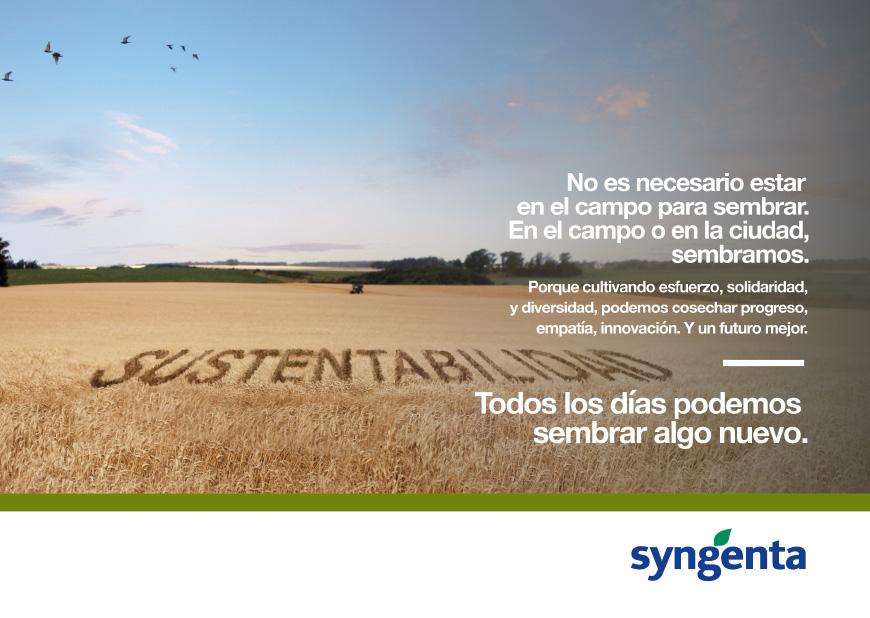
Climate change has become a direct threat to agriculture. Droughts, heat waves, and other extreme phenomena are affecting yields, evidencing the necessity of adapting agricultural practices to new realities. "Agriculture involves practices that reduce GHG emissions and protect the soil and biodiversity, yet economic benefits encouraged by state or market policies are essential," Basso claimed.
In this context, bioeconomy emerges as a key approach, where society does not only see agriculture as a source of food but as a pillar of a circular economy. ‘Raw’ products leave the field transformed, promoting a more efficient and sustainable use of resources, such as water and nutrients. "The main message is the economic benefits provided by agriculture, not only through food production but also through selling ecosystem services and transforming non-food products, such as fibers, bioenergy, carbon sequestration, etc."
"Agriculture involves practices that reduce GHG emissions and protect the soil and biodiversity, yet economic benefits encouraged by state or market policies are essential."
To move toward new paradigms, it is important to transform scientific principles into concrete innovations. However, farmers are businessmen, and assuming the risks of change is a complex challenge that should be addressed from a broader and more transdisciplinary approach.
Here, artificial intelligence (AI) is presented as a primary ally, helping farmers visualize the impacts of different management models. One of the most promising tools for this transformation is the use of digital twins. These are digital replicas
of agricultural fields that enable the analysis and prediction of land performance under different scenarios, providing a deep understanding of the agricultural system’s complexity, including the interaction between weather, soil, genetics, and management practices (Image 1).
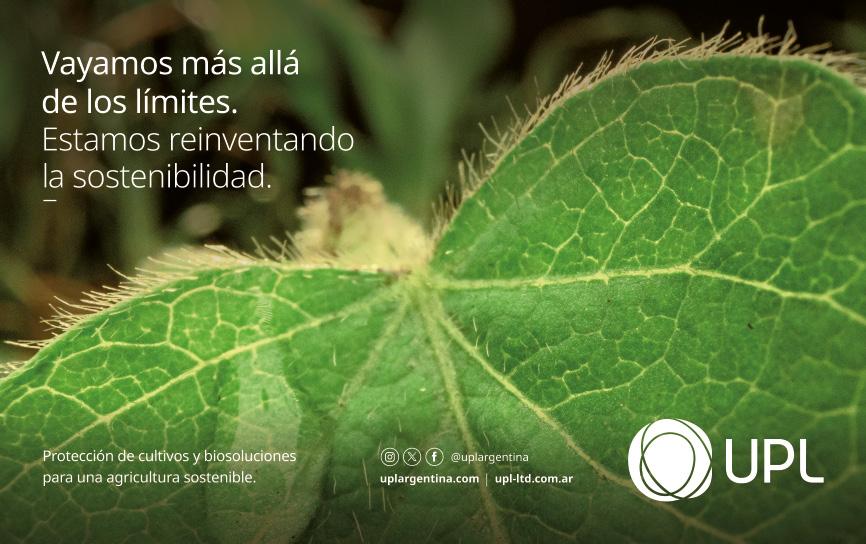

Image 1. Use of digital twins for solutions dissemination.
Dr. Basso emphasized the importance of advanced modeling, which, along with data science and machine learning, enables producers to make more informed and precise decisions. "The integration of these technologies is not science fiction anymore, it is a reality," he claimed. Due to these tools, it is possible to quantify carbon intensity and emissions balance, crucial aspects to meet the sustainability requirements in markets like Europe and the United States.
Now, this powerful technology helps farmers to reduce their environmental impact and also opens doors to new markets and economic benefits. For instance, the use of stability maps, which consistently identify high and low productivity areas in a field, as well as areas where conservation practices may be more effective (Image 2).
"By assessing productivity in 80 million acres, we discovered that yields are always high in 48% of the surface, while in 25% yields are always low to the point of negative economic benefits and losses of between 300 and 400 dollars/ha," Basso said. These large surfaces represent an important
opportunity to transition from conventional production toward the development of ecosystem services, planting evergreen and biodiverse crops. This change increases profitability and contributes to enhancing biodiversity and reducing emissions, enabling the selling of these ecosystem services.


Image 2. Profitability map of precision conservation: this map enables variable applications of nitrogen and increases biodiversity.
Argentina holds a privileged position in this new agricultural paradigm. With the massive adoption of no-till farming, the country has proven to be a leader in sustainable practices without needing governmental subsidies, which is a competitive advantage over other nations. However, Dr. Basso said that this advantage has not yet been fully exploited: "Argentina is not making good use of this gold mine it is seated on."
This 'gold mine’ is the capacity of the country to monetize its sustainable agricultural practices by selling ecosystem services and participating in international markets that value carbon emissions reduction.

Image 3. Carbon balance estimated by SAF (Sustainable Aviation Fuel). No-till farming is the only system capable of net carbon sequestration.

The path towards monetization entails technology implementation that enables farmers to quantify and certify their sustainable practices (Image 3). This ranges from the use of cover crops up to the optimization of fertilizer usage, always considering emissions reduction.
Precision agriculture and soil conservation are vital parts of this process, as they allow efficiency improvement and environmental impact reduction while generating additional incomes.

Dr. Basso stressed the importance of publicprivate alliances and the need of governments to support farmers in this transition. "The farmer cannot take on the total of risks and costs; it is necessary for interested companies and the government to play an active role in developing platforms that enable the quantification of carbon sequestration and emissions reduction.”
Benefiting from its advantageous position and new available technologies, Argentine agriculture has a unique opportunity to lead the transition toward a more sustainable and profitable model. The key lies in circularity and sustainability, and Argentina has all the resources to become a world leader on this new paradigm.
The path towards monetization entails technology implementation that enables farmers to quantify and certify their sustainable practices.


A distinguished panel addressed the challenges faced by agrifood systems and bioeconomy in the American continent, as well as the strategies to combat climate change and improve food security.
Moderated by the agricultural economist Marcelo Regúnaga, within the “Bioeconomy” axis at the Aapresid Congress, a panel gathered distinguished international speakers: Hugo Chavarría from the Inter-American Institute for Cooperation on Agriculture (IICA); Nicolás Bronzovich, secretary of Agriculture in Argentina; Talita Priscila Pinto from the Getulio Vargas Foundation in Brazil; and Doug Berven, vice president of Corporate Affairs
The panel debated how bioeconomy can help the agricultural sector generate added value in their traditional productions, contributing to energy transition and generating positive impacts on sustainability’s three dimensions: economic, social, and environmental.
Hugo Chavarría, director of the Innovation and Bioeconomy Program at IICA, stressed the need



all known biodiversity, and eight of the world’s fifteen most megadiverse countries can be found on only 15% of its territory. Moreover, the region has 16% of marine resources, 50% of amphibians, and it is the largest biomass producer and exporter globally
Chavarría said, however, that "despite the Americas’ large biodiversity, only between 20% and 30% is mapped and identified." He added: "The Americas are important actors in the international market of grain, oilseed, tropical fruits, and meat, but most of this production is primary and has low added value. In fact, only 33% of agrifood exports have some level of added value," (Figure 1).

Chavarría also said that, even though it is a distinguished region regarding production and exportation, it is facing inefficiencies throughout the chain, limiting its potential economic development. In primary production, a great part of it is lost, and a high percentage of biomass is considered waste.
The economist concluded that bioeconomý should be the development model to imitate, with added value and sustainability as strategic pillars.
Although several bioeconomies coexist in the Americas, many challenges and opportunities are shared. Consequently, it is essential to work together, form alliances, and promote
synergies among the public and private sectors, international organizations, and research institutions to use these advantages and obtain competitive and comparative benefits.
Although several bioeconomies coexist in the Americas, many challenges and opportunities are shared. Consequently, it is essential to work together.

The Argentine Secretary of Agriculture, Agr. Engr. Nicolás Bronzovich, stressed the relevance of sustainability and value creation in the Argentine agroindustry. According to Bronzovich, the Argentine agricultural sector shows robustness and resilience season after season, assuming a central role in the global market of food and fibers.
Despite having faced one of the worst droughts in 2023, Argentina contributed 12% to the world commerce of grain and its by-products, and it is responsible for two-thirds of domestic exports. Moreover, the sector generates 3.7 million job positions, equal to 24% of private jobs in the country.
The secretary also praised the adoption of no-till farming, which has transformed the agricultural industry in South America. This practice helped save between 300 and 350 million liters of diesel oil per season, increased yields, and improved productivity without the need to expand cultivated land.
Bronzovich also highlighted biotechnology’s primary role in the adoption of technologies in the Argentine agricultural sector. Since the registration of the first genetically modified organism, RR soybean, in 1996, Argentina fastly advanced toward genetic technology (Figure 2). The country has more than 80 genetically modified organisms certified in 2024, including microorganisms for animal health and yeast for bioethanol production.
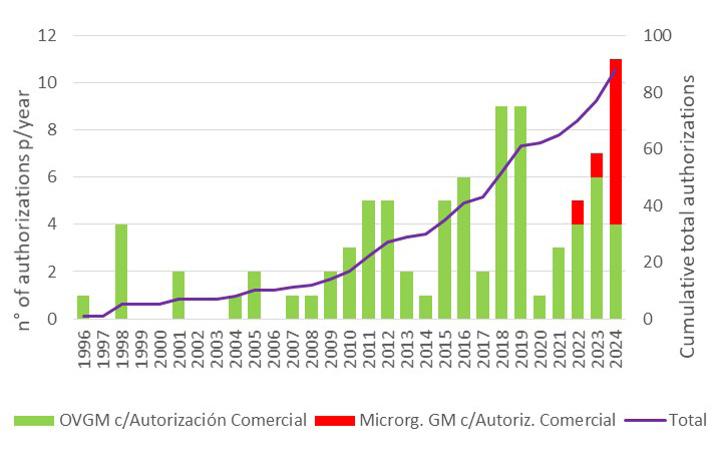
2. Genetically modified organisms commercially authorized in Argentina since 1996.


Upon closure, the secretary talked about the need to reduce distorting regulations, improve product quality, strengthen intellectual property, and promote public-private cooperation. Internationally, he advocated for protecting the multilateral trading system, cooperating in technology assessment, and accentuating the positive environmental features of productive systems in the Americas.
Brazil: developing a domestic bioeconomic strategy
Talita Priscila Pinto, coordinator of the Bioeconomy and Innovation Observatory from the Getulio Vargas Foundation in Brazil, discussed the development of bioeconomy in her country and its potential in Latin America. The economist explained how advances in life sciences, alongside engineering and technology, are transforming various industries and promoting global economic growth.
Pinto said the concept of bioeconomy addresses the creation of new bioproducts and bioservices, as well as R&D reformulating the structure of various industries. These advances integrate economic activities with the environment, promoting the replacement of fossil resources with biological ones in the production of electricity, fuel, and manufactured goods. Bioeconomy is still evolving, reflecting the natural and technological diversity across
the entire world.
However, the lack of a consensual definition of bioeconomy among countries hinders international comparisons and agreements that could generate trading advantages for the region. Therefore, Brazil and the Getulio Vargas Foundation are working on the development and refinement of sustainability metrics and criteria that enable the assessment of the economic and environmental value of bioeconomy, focusing on the use and transformation of biological resources.
As leader of the G20, Brazil has designed specific strategies to advance in the field of bioeconomy.
In this context, Brazil has published a document reflecting the alignment of members of the group
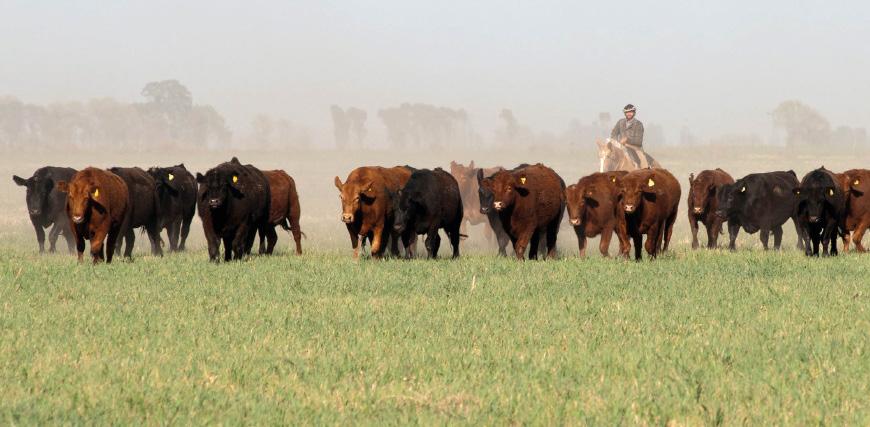
Acompañamos el crecimiento de nuestros productores para que sean artífices del desarrollo federal.
on three key thematic axes: biotechnology (research, development, and innovation), bioresources (sustainable use of biodiversity), and bioecology (sustainable development).
Among essential factors for the development of bioeconomy in Brazil, Pinto commented on the economic and sustainability boost, as well as the integration of productive systems with territorial identity. She concluded by urging more effective regional collaboration to combat technical and institutional challenges and make the most of bioeconomy's potential.
Doug Berven, vice president of Corporate Affairs at Poet, the largest biofuel producer in the world headquartered in South Dakota, United States, mentioned the crucial role of biofuels in agriculture and their positive impact on the global economy.
Poet generates 3 billion gallons of ethanol and 975 million pounds of corn oil yearly. Moreover, the company captures millions of metric tons of CO2, significantly contributing to emissions reduction
Berven said that agriculture is crucial to face current global challenges like climate change, poverty, and hunger. Similarly, he mentioned that increasing corn production and ethanol expansion help balance the markets, positively impacting the reduction of global malnutrition. He claimed that, by focusing on improving

yields, recovering fallow lands, and promoting smart crop production, carbon sequestration rates could be increased, enabling agriculture to achieve a neutral carbon balance by 2030
According to Berven, bioeconomy and circular economy will be crucial to mitigate climate change and strengthen global food security.
To conclude, Marcelo Regúnaga reflected on the challenges the productive sector will have to face in the coming years. He said that recent scientific and technological advances represent a unique opportunity to promote economic, social, and sustainable development. This ambitious agenda on bioeconomy shows great potential to add value to numerous productive activities. However, it is essential to enhance knowledge transfer and to collaborate with multiple actors to progress in this stage.
This ambitious agenda on bioeconomy shows great potential to add value to numerous productive activities.

Specialists from the University of Tennessee presented their research on circularity and the use of high-performance computing to develop agricultural solutions in record time.

On the first day at the Aapresid Congress, specialists from the University of Tennessee (UTK)–Forbes Walker, David Ader, and Deborah Penchoff–led the panel titled "Food-waterenergy: circular and climate-smart approach". During the presentation, Forbes Walker, a soil scientist at UTK, showed the multiple ongoing studies at the university and its eight specialized departments, each focused on a specific area.
Walker provided a detailed description of the climatic conditions in Tennessee and the main crops in the region: "Our weather is humid and temperate, with precipitation of 1200 mm, and between 180 and 220 frost-free days. We sow from April to June and harvest from September to November. The main crops in the area are 625,000 ha of soybean, 360,000 ha of corn, 160,000 ha of wheat, and 100,000 ha of cotton," he explained.
The UTK organizes field days to address key subjects such as new technologies, cover crops, and water management, aiming for continuous updating.

One of the main research areas at the University is no-till farming, a practice employed in response to severe soil erosion faced by growers in the region in the 1970s. "We are very proud to claim that Tennessee has the highest rate of no-tillage implementation in the country, with 93%, the highest in the United States," Walker said. Notillage did not only enhance soil health but also increased the productivity and sustainability of agricultural establishments.
Walker also mentioned that they are currently researching other topics, such as cover crops, aiming for a better understanding of their impact on soil health and crop yield. He made it clear that these crops are here to stay.
During his presentation, Walker revealed data from the “Milan No-Till Field Day 2024”, highlighting the effects of multi-species cover crops on yield and soil health under different crop rotations.
“We are very proud to claim that Tennessee has the highest rate of no-tillage implementation in the country, with 93%, the highest in the United States.”

Table 1. Effect of different cover crops on yield and weed control of successor crops like soybean and corn.

Table 1 shows different crop yields under several types of cover crops: no cover, wheat, clover, wheat-clover mix, and a five-species mix. Multispecies cover crops tend to provide greater cover biomass and yield benefits. Particularly, the fivespecies coverage system shows the best results, with a total score of "4.23" in the "Sum of benefits".
Moreover, table 1 analyzes different cropping systems: continuous corn, continuous soybean, and corn-cotton-soybean rotation. The latter provides the greatest benefits, with a total score of
"3.62", suggesting that incorporating cover crops in rotation improves both yield and soil health.
Walker also presented a report by Dr Nutifafa Adotey, which provides information about the use of different sources of nitrogenous fertilizers (urea vs UAN).

Graph 1. Effect of different nitrogenous fertilization treatments on yield.
Graph 1 shows obtained yields under different nitrogen treatments (N). The red bar suggests that yield can vary depending on whether the N source is treated with a stabilizer. "It is important to treat both urea and UAN with a N stabilizer," Walker explained, and added: "Regarding yield, strip-organized application is more efficient than its distribution over the entire area.”
Moreover, Walker advised not to apply more than 180 pounds/acre of N to avoid losses and damage to the crop. The recommended nitrogen application is 1/3 during sowing and 2/3 at the V6 stage.
Walker also mentioned a research project exploring the viability and benefits of oilseeds for the production of sustainable aviation fuel (SAF), stressing the importance of governmental support and its potential impact on reducing C footprint in aviation.
“Waste should not exist; we need to find a way to recycle and give it value, changing our mindset.”

Regarding circularity, Sustainable Agriculture professor at UTK, David Ader, spoke about the need to target clear sustainable development goals. "Waste should not exist; we need to find a way to recycle and give it value, changing our mindset," Ader said. According to the specialist, not only growers should think about circularity but it also requires governmental support. "Politicians should incorporate it, and kids should learn this at school."
"In agriculture, we are all brothers and sisters; we are not competitors but collaborators in the search for sustainable solutions," Ader concluded.
The UTK also uses high-performance computing to solve agricultural and environmental problems. Deborah Penchoff, director of the Innovative Computing Laboratory (ICL) at UTK, explained how they use these resources to obtain agricultural solutions and restore the environment.
Penchoff emphasized that computer science is a multidisciplinary field, where data analysis enables finding solutions without the need for a laboratory, avoiding possible contamination of results and delays in performing repetitions.
"Most importantly, computing sciences can accelerate solutions," Penchoff said. "Highperformance computing has progressed significantly since the 90s, mostly boosted by artificial intelligence (AI). We are currently in the Exascale era, where computers can operate at a speed that could otherwise take humans way too many years.”
One specific project they have at the ICL is AI application for environmental restoration, meaning they use artificial intelligence to find methods for eliminating contaminants introduced into the environment by humans.
The participation of the University of Tennessee in the Aapresid Congress offered a model of how cooperation and the adoption of new technologies can transform global agriculture.


Leaders in biotechnology presented the latest strategies for pest and disease control, from new genetically-modified crops to the creation of innovative modes of action.

Pests and diseases represent a persisting issue for agriculture, causing significant losses in the productivity and quality of crops. In the past decades, their control has been focused on the use of plant protection products and the cultivation of genetically-modified crops, such as corn, soybean, or Bt cotton, which are genetically modified to express the genes of the Bacillus thuringiensis (Bt) bacteria.
However, the intensive and repetitive use of these strategies has caused problems like the appearance of resistant insect populations. In Argentina, for instance, three cases of Bt crop resistance have been reported: two in Diatraea saccharalis (sugarcane borer) and one in Spodoptera frugiperda (fall armyworm). As a consequence, the development of new strategies that exceed these limitations is crucial.
In this context, the Aapresid Congress convened two experts for the “Biotechnology” section: Juan Luis Jurat Fuentes from the University of Tennessee and Federico Ariel, researcher at
Biotech. Both specialists agreed on the pressing need of exploring new technologies to ensure a more sustainable agricultural production.
As regards genetically modified crops, Juan Luis Jurat Fuentes mentioned several alternatives. Firstly, he commented on the development of new Bt plant varieties that generate active insecticidal proteins against already resistant pests, such as BtMAX corn, which produces Cry1D protein.
Another developing option, which may be used in the near future, is to enhance these proteins to reduce the frequency of survival insects. Therefore, his team is working on the incorporation of a bridging or adhesive protein, called synergist, which increases the union of Cry1F with intestinal receptors of the target insect, in this case, the fall armyworm. Thus achieving a more effective control with smaller doses.
A third promising option is the creation of bioinsecticides with modes of action different from Bt, such as gene silencing technologies



vital protein in the insect. Once inside the insect, these chains unite, and the target RNA cannot be used. Consequently, the production of this protein is blocked, which is the molecule that actually has the function in the organism, and then the insect dies. This technology is distinguished because of its high specificity and environmental security.
Similarly, Federico Ariel showed technological advances based on RNA for pest and disease control. Through the CONICET, Argentina is investigating the possibility of non-transgenic gene modulation in plants as a control method
for pests and diseases (Figure 1). According to the specialist, an area enabling progress toward technology development for agriculture is the study of plant-specific immunity to certain pathogens based on the RNA molecule. Apolo Biotech is developing an RNA-based technology that acts as a vaccine for plants. "We isolated segments of the pathogen's genome to obtain messenger or interference RNA; later, these molecules are sprayed to plants. Once absorbed, they can silence pathogen-specific genes and block the infection," he explained (Figure 2)


2. RNA technology in plants: steps from laboratory to field.

Luis Jurat Fuentes from the University of Tennessee commented on how to boost and extend the use of Bt technologies and develop bioinsecticides based on RNA technologies.
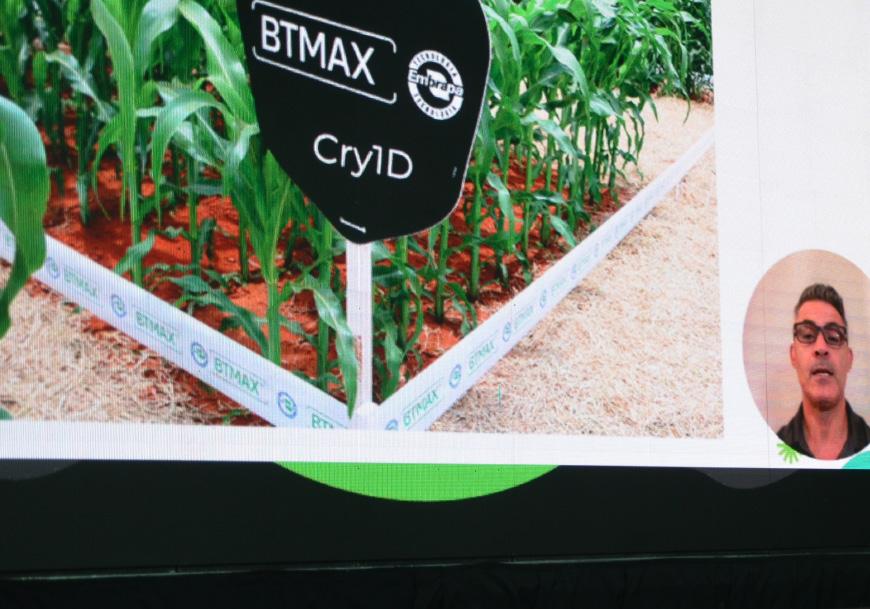
Therefore, carriers or conductors that stabilize molecules are being employed, which are later absorbed and processed by plants. Apolo Biotech is already using this technology for fungus control, such as Botrytis cinerea, Phytophthora infestans, or Sclerotinia sclerotiorum in tomato, with promising results in both the laboratory and the field.
The advances shown at the Aapresid Congress are evidence of the numerous innovative alternatives for pest and disease control, ranging from enhancing and extending the use of Bt technologies to developing RNA-based bioinsecticides. These strategies would enable the design of highly specific and environmentally sustainable models.
Through the CONICET, Argentina is investigating the possibility of non-transgenic gene modulation in plants as a control method for pests and diseases.









‘Is creativity made or born within the individual?’ Estanislao Bachrach visited the Aapresid Congress to answer this and other questions, exploring ways to be innovative in a world
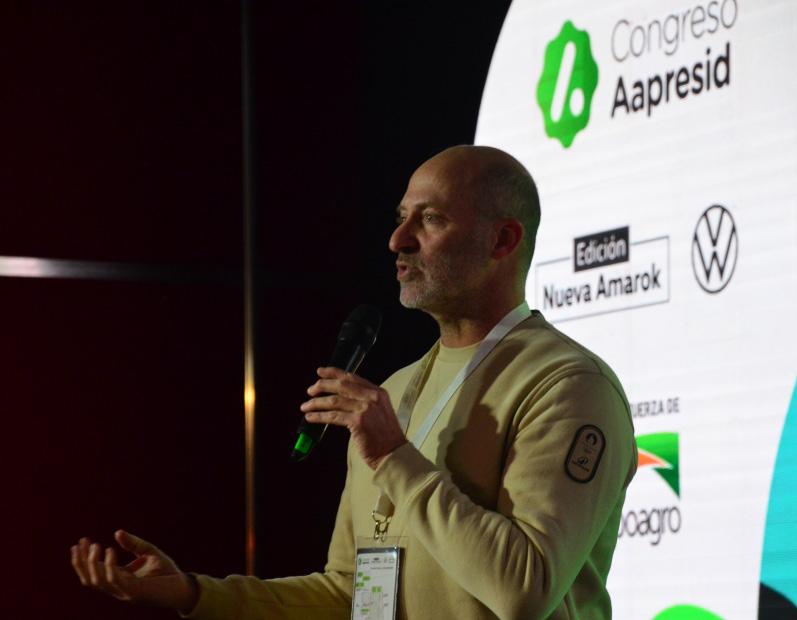
Within the framework of the axis "Communication and education" at the Aapresid Congress, supported by Enrique García and Byontek, Estanislao Bachrach, a distinguished molecular biologist specialized in leadership, emotional intelligence, and creativity, offered a conference focused on the latter. "Which characteristics are involved in order for a person to be creative?" Bachrach asked himself at the beginning of his presentation.
As an answer, Bachrach quoted the HungarianAmerican psychologist Mihály Csíkszentmihályi, who identified three common features associated to creativity in the 96 most creative minds in history: the intention or desire to be creative, some sort of
"Creativity is like any other ability, it can be learned," Bachrach said, and compared the process of learning to be creative with learning English or playing the piano: the more we practice, the faster we learn. Therefore, a good teacher, proper methodology, specific techniques, and discipline are needed.
brain alteration that makes them different, and the capacity to see things from multiple points of view. However, only 2% of the world population has these distinguished features.
Although we all have abilities that can be developed through learning processes, talent is innate and is still a mystery for science, defining it as ‘that which science cannot explain’. Nevertheless, it is possible to express creativity. This process, which requires effort and discipline, should also include the ludic element. Being relaxed enables individuals to be in contact with the present in order to free the mind from possessions.
“Creativity is like any other ability, it can be learned”

Bachrach also demystified the idea that people’s age or educational background influences the capacity to learn to be creative. "The myth that young people learn faster than old people is fake," he claimed. Thus, he said that biology has proved that, as we get older, we usually are eager to keep learning, which is a determinant for the development of creativity.
Why are there so few creative people?
Bachrach pointed out that the current education system, as outdated as it is, “does everything it can for people to be as less creative as possible.” This is because of instilled dogmas and ways of studying, working, and understanding a world that often leaves aside the use of creativity from an early age.
According to Bachrach, schools tend to lead students to walk through life on three ‘lanes’ representing creativity's main ‘enemies’. The first is the certainty lane, as creativity flowers from uncertainty. The second is experience, as creativity nourishes from what is new. The third lane is culture, which determines the modes of acting and thinking. To be creative, it is necessary to step away from these ‘lanes’ and venture into other paths that formal education tends to limit.
After visiting large multinationals in Asia and the United States, and studying their productive systems, Bachrach concluded that many companies’ success in terms of innovation resides in the opportunities they offer their employees to train them for creativity or innovation.
Creativity is a mental process in which novelty and valuable ideas emerge, while innovation is the execution of these ideas. The development of these skills impacts the way of working, the processes, and the results of the products or services offered by these companies.
“Many companies’ success in terms of innovation resides in the opportunities they offer their employees to train them for creativity or innovation”




Biological Brainstorming is a technique in which a working team proposes ideas to solve a particular issue or improve a certain aspect without initially worrying about viability. The goal is to reach a final, innovative idea that can be carried out.
To put this technique into practice, it is important to follow a series of steps. In the first stage, the aspects of the area to be worked on should be researched and studied. This process is called 'absorb' and refers to the absorption of information by the brain. Then, at the stage of 'envision', as many ideas as possible are provided during a maximum of one hour, because this process can be very exhausting. Finally, at the 'incubation' stage, occurring when people are relaxed after the previous step, is when those valuable ideas emerge.
These ideas usually appear when the mind mixes concepts that are seemingly not related with each other, a phenomenon known as 'conceptual blending'
From a biological perspective, human beings have two ways to generate ideas: through logic and 'insights'. Insights are sudden ideas, with no clear explanation, which are electrically connected and known as gamma waves: every time electrical peaks with gamma waves are produced in the brain, new ideas arise. When the brain is involved in intense and focused
mental activities, the presence of beta waves predominates. Whereas in a relaxed state, alpha waves predominate. According to Bachrach, "the more alpha we are, the more gamma we become," meaning that relaxing states facilitate the origination of new ideas.
To conclude, the biologist encouraged the attendees to put these techniques into practice with their working teams to boost creativity. Consequently, he advised setting times and spaces intended for the generation of novel ideas, leaving aside hierarchies or educational differences. Bachrach also encouraged letting go of those elements conditioning thinking and to dream big, as “the more fresh ideas emerge, the better the probabilities of one that generates value."


“Let go of those elements conditioning thinking and dream big, as “the more fresh ideas emerge, the better the probabilities of one that generates value.”

World leader in soil science, Rattan Lal, the director general at IICA, and distinguished international specialists analyzed how carbon capture, bioeconomy and policies can boost the region's agriculture.

Participating on an outstanding panel were Director General Manuel Otero from the InterAmerican Institute for Cooperation on Agriculture (IICA); Rattan Lal, a world leader in soil science from the Ohio State University, World Food Prize laureate in 2020, and co-winner of the Nobel Peace Prize 2007; Joachim von Braun, Bioeconomy specialist from the University of Bonn in Germany; Izabella Teixeira, special advisor at IICA and former Minister of Environment of Brazil; and Kip Tom, grower and former Ambassador of the United States before the UN. The panel discussed the opportunities for agriculture in Latin America and the importance of soil health as a solution for current challenges with regard to food and climate security. Moreover, the speakers talked about the essential role of bioeconomy, public-private articulation, and growers in promoting innovation and sustainability.
To challenge the audience, Manuel Otero asked: "Can agriculture save the planet?" To answer this question, he spoke about the great challenges the sector will have to face, such as, ensuring food security, addressing the climate crisis, increasing nutritious food production, progressing on energy transition, and revitalizing rurality.
Otero recalled that it is not the first time agriculture has faced such challenges. From the Great Depression in the 30s and the wars, up to the recent COVID-19 pandemic, it has proven notable resilience. "The narrative matters," said IICA’s president, urging to enhance messages aiming at conveying that agriculture is not the cause of the problems but the solution. He also encouraged growers to be self-critical and to adopt the primary and proactive role required by modern times.


Otero concluded: "We have the future of agriculture in our hands. The next 25 years will be crucial and more important than the previous 10,000 years. We must unite and work in a convergent direction, which is IICA's philosophy. We need the cooperation of all actors and diverse financing sources to confront the abovementioned challenges."
Likewise, Izabella Teixeira deepened the debate from two perspectives. On the one hand, she mentioned climate change as a disruptive process that not only demands emissions mitigation but also the development of adaptation measures and strategies for food production. On the other hand, she discussed agricultural protectionism measures and tariff barriers imposed by some nations on international trade. Regarding this point, she stated: "We have to go against both climate change and agriculture deniers. Nature deforestation and degradation should be the past; we have to understand how to conserve the soil. Carbon sinks are often not recognized internationally."
Teixeira insisted that the private sector should be transformed into a strategic political player, capable of understanding market and business models, as well as how to manage protectionism in international trade. In addition, she stressed the vital role of scientific institutions in providing clear data for accountability at a regional level, with a core addressing the interest of the sector and promoting solidarity in the fight against climate change.
The specialist urged considering the agricultural sector as a driving force for development, social protection, and job generation. She concluded with a thought: "Growers have to understand the agenda, know where we are standing, and how we should advance into the future. We should convince the world that we are part of the solution and that we are capable. Latin America, as a region of peace and democracy, has many opportunities."
In accordance with the previous speakers, Kip Tom reinforced the imperative need for growers to be involved in discussions and decisionmaking when formulating policies that reflect their needs, as growers are the ones employing these processes and investing their money. In addition, he mentioned the value of adopting science and technological innovations to improve crop yields and reduce the carbon footprint. However, he warned that many countries lack food security due to policies not considering it, or directives from Europe. Tom explained that this happens in 60% of the areas receiving humanitarian aid because they were not allowed to get the innovation they need, not even the simplest tools. Encouraging deep reflection, he added: "We have to ensure global policies that contemplate the three pillars of sustainability: environmental, economic, and social."

To offer an outlook on bioeconomy, Joachim von Braun explained that it is emerging as a transformative force for sustainable development by integrating biotechnology advancements and digital tools with the main principles of a circular economy. He stated that bioeconomy offers solutions because it mitigates environmental impact, promotes growth and economic integration among sectors, and improves social welfare. Additionally, bioeconomy manages environmental products like carbon credits and renewable energy certifications, and encourages commercial relations as it benefits sustainability. On this line, von Braun said: "This is very important for Latin America, as the region is an important food supplier."
At a global extent, von Braun stated that there has been an acceleration in the adoption of policies related to bioeconomy in the past five years, with Latin America and Argentina at the forefront (Figure 1). With an optimistic view for our region, he concluded: "I see great opportunities for Latin America and the Caribbean as leaders, due to resource richness, biodiversity–the cornerstone of a flourishing bioeconomy–and their scientific capacity."



Rattan Lal mentioned several landmarks on the evolution of agriculture, emphasizing that, even though the Green Revolution saved millions of people from famine, today we are facing new challenges like global warming, soil degradation, and food insecurity. To disclose numbers, he said that one-third of soils are degraded, having lost their multifunctionality and productive capacity, with a cost of U$S 400 billions/year. Moreover, CO2 emissions and nitrous oxide represent 15% of the global increase due to the anthropogenic use of the soil. In addition, grain as staple food is less affordable, with one in eight people suffering from food insecurity, and between two and three in every eight experiencing malnutrition.
Lal claimed that 21st-century agriculture needs more fertilizers and more irrigation, but it should be based on soil resilience and more efficient ecosystems, promoted and transformed by science, digital tools, and artificial intelligence.
Lal explained that this new context leads us toward regenerative agriculture, inspired by ecoinnovation, circular economy, green infrastructure and biofuels, and whose foundation is terrestrial biosphere decarbonization and sustainable development. Following the principles of agroecology and imitating nature, new agricultural methods increase yields while reducing environmental impact, accomplishing more with less. Thus, Lal emphasized the need for generating more biomass, implementing biodiversity systems for nitrogen fixation and nutrients cycling, adding service crops, and integrating livestock farming. "The system should be holistic in order for soil health to improve," he stated.
According to Lal, true change lies in the transformation of land management following the 5 R's: Reduce, Reuse, Recycle, Recover, and Repair. Here is where modern agriculture appears, although policies pro-farmer and pro-nature are needed.

“We can’t build a world of peace on empty stomachs and human misery”








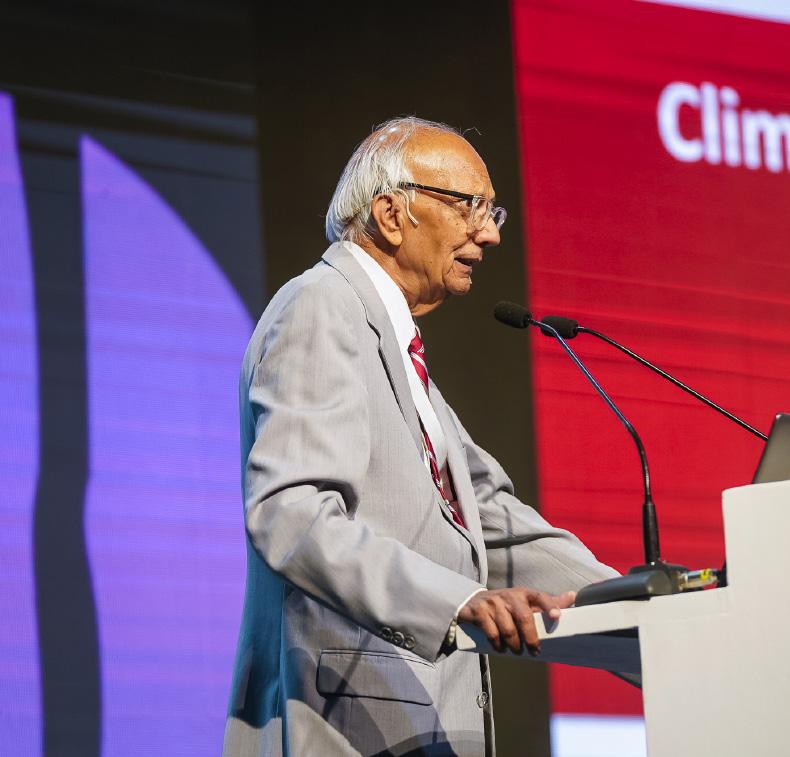
“Saying that transformation has to happen but we are not willing to pay for it is pointless. There is no free meal. This will make agriculture the real solution," Rattan Lal.

Lal claimed that soil carbon sequestered by agriculture is currently a commodity from which growers can obtain incomes. "If we can introduce these new policies and adopt science-backed technologies, we could maintain global warming below 2°C. This is still possible and agriculture can make a difference in this sense," he said.
Lal also said the dilemma is who pays that service to the grower. He suggested that fossil fuel exporters, agroindustries, and the private sector, should pay a premium; with consumers willing to pay for food that is properly and scientifically cultivated. "Saying that transformation has to happen but we are not willing to pay for it is pointless. There is no free meal. This will make agriculture the real solution," Lal concluded.



Specialists from Brazil, Mexico and Argentina spoke about management strategies for the vector of corn stunted growth. Genetics, predictive models, and satellite images are among the key techniques to address this issue.

One of the panels focused on the corn leafhopper was led by specialists Mauricio Pasini from Intagro and Lucas Fadda from the Instituto de Ecología Inecol, who shared their knowledge about management strategies employed in Brazil and Mexico. Dalbulus maidis, the infamous leafhopper, represents one of the greatest issues for corn in Latin America, capable of reducing yields by up to 100%.
Lucas Fadda explained that this insect is widely distributed across Mexico's tropical areas, adapting to diverse latitudes ranging from sea level up to 3200 meters. Besides affecting corn, some same-genus species can feed and reproduce in other grasses during dry seasons. In Mexico, there are two leafhopper species transmitting this group of pathologies, including the maize rayado fino virus, corn stunted growth, and bushy stunt.
Fadda said that one of the most effective strategies for the control of the leafhopper is the selection of corn hybrids with tolerance to stunted growth, and that several hybrids have shown good tolerance in different regions in México. "Certain types of corn produce large quantities of volatile compounds when attacked by the leafhopper," he explained. These volatile compounds not only enable the females of the

pest to discern between attacked and nonattacked plants, but they also attract natural parasitoids, such as the Anagrus virlai wasp, which feeds on leafhoppers and helps control their population. Moreover, he mentioned a case in Argentina where a local corn variety produced six times more volatile compounds than hybrids, achieving a more effective biological control.
Predictive models are another essential tool to combat Dalbulus maidis. "There are correlative models using georeferenced information and mathematical algorithms to identify those areas where the pest may establish or be already present," Fadda said.
Although satellite images are also useful to detect issues related to the leafhopper, the commonly used NDVI only detects the presence of the pest when the infestation levels are high. Consequently, Fadda suggested using the GCVI, which offers higher resolution and sensitivity for early detection.
Mauricio Pasini suggested eliminating wild corn in order to reduce the leafhopper population and stressed the importance of choosing proper hybrids and ensuring good crop nutrition. He also said that plant protection applications should be performed with quality and at the proper time, preferably at night to maximize efficiency.

Both specialists agreed that leafhopper management requires a multifaceted approach that combines genetic resistance, biological control, predictive models, and advanced technologies. Employing these strategies integrally can considerably minimize the impact of the leafhopper on corn crops.
Argentine outlook: how to move ‘from drama to action’
In a full capacity main auditorium, another panel addressing the leafhopper featured Augusto Casmuz from the Argentine experiment station Obispo Colombres (EEAOC) and Ines Catalano from the Universidad Nacional del Noroeste de la Provincia de Buenos Aires (UNNOBA). The panel delivered all the knowledge collected from last season, which will be key in forthcoming cultivations. Casmuz agreed with Pasini and Fadda that managing this pest requires multiple strategies.
“There are correlative models using georeferenced information and mathematical algorithms to identify those areas where the pest may establish or be already present.”
Y DJI AGRAS T50
Fuerza extra para la protección de su cultivo

Escanee
Conozca nuestra nueva línea de drones, que potencializan la protección de su producción, sumado a la robustez y eficiencia de pulverización de los Uniport 3030 y 4530.
jacto.com
Consequently, Casmuz presented a pyramid of factors that define their behavior and should be considered when planning their management (Figure 1). At the base of this pyramid is, no more and no less, than the proper management of the vector.

The concentration of sowing dates resulted in a key matter. A 2023 data analysis from an area where corn cultivation occurs in summer observed how D. maidis adult populations and their infection percentages followed the growing rhythm of the crop.
In December, when planting, populations were around 30 adults/trap, with infection levels at 10%. Throughout the crop cycle, populations grew significantly, reaching between 1000 and 1200 adults/trap and infection levels at 67% in May (Figure 2a).
In areas with staggered planting, which started in September with early corn and extended to the end of the year with late corn, the ones sown in December began with vector levels of 250 adults/trap and infection levels of 20%, derived from early corn. In May, late corn reached more than 2500 adults/trap and infection levels above 70% (Figure 2b).
"Every corn standing was an infected corn," said Casmuz, emphasizing the importance of "planning the sowing windows, as they impact directly on the pest dynamics."
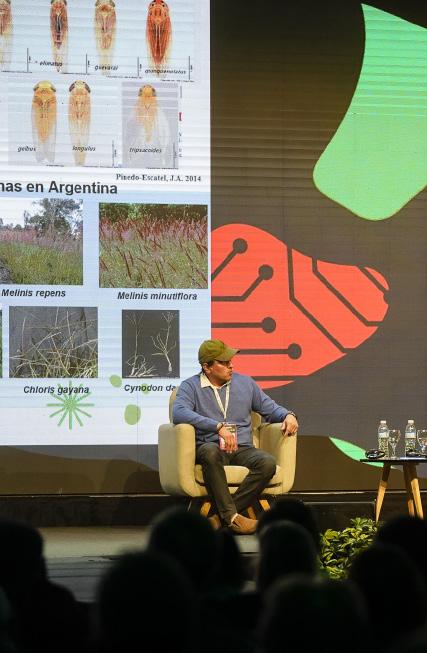



2. Dalbulus maidis populations in: (a) area with concentrated sowing in summer, December-January; and (b) area with extended sowing from spring to summer, September-January.
The panel also discussed the first results of the Red Nacional de Monitoreo de Dalbulus maidis (see box below), presented at the Congress. These results show that, even though frosts reduced populations, they did not stop the pest, which is still very present in areas like Northwest Argentina (NOA) and the center of the country (Figure 3).
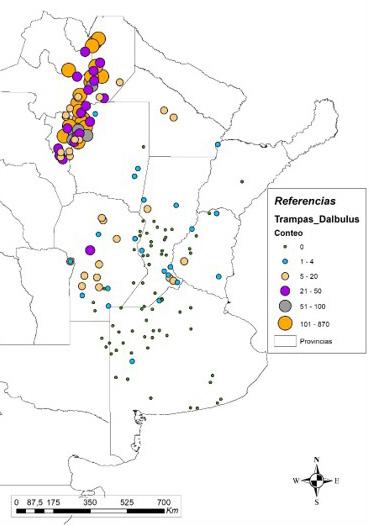

This network, known as the Red Nacional de Monitoreo in Argentina, was created by Maizar, the EEAOC, Aapresid, the Asociación Argentina de Protección Profesional de Cultivos Extensivos (AAPPCE), CREA, and INTA to respond to stunted growth issues affecting corn.
Since it was established in May, the network has been studying populations of the vector through 450 traps placed in different regions of the country.
Another decisive strategy for managing the vector is wild or volunteer corn control. "During the last harvest, a large quantity of spikes and grain fell to the ground. Wild corns born from there will not only be food and refuge for the vector, but they will also be inoculum for the group of pathologies it transmits, as most of these corns are infected. Also, it is not the same to have 100 leafhoppers with infection levels of 3% as 100 with 60%," Casmuz stated, and added: "This pest demands management strategies throughout the whole year. We cannot be focused only during cultivation periods."
Monitoring is another strategic pillar. Casmuz said that leafhopper monitoring should be continuous and systemic: "It is a moving pest that cannot be seen in the plot at all times and requires training in agricultural activities."
In the case of this pest, chemical control is at the top of the management pyramid; meaning that without proper management of the vector population as the foundation, their effectiveness is limited. Seed treatments are effective but only protect the crop during its first stage. "Companies and technicians' efforts are needed to adjust the dose of these treatments to the Argentinian
reality," Casmuz said, mentioning that seed treatments, although being adopted, may affect seeds' physiological quality.
“This pest demands management strategies throughout the whole year. We cannot be focused only during cultivation periods.”
Regarding foliar applications, Casmuz mentioned their effectiveness among low populations of the vector but emphasized constant monitoring and treatments after V8, because the pest still affects yield and grain quality beyond this phase.

Bioinputs are crucial components for achieving sustainable agricultural production. Experts from Germany, Uruguay, and Argentina have analyzed strategies to overcome current barriers and facilitate their adoption.

The German-Argentine Dialogue on bioinputs, as well as the German-Uruguayan, were present at the Aapresid Congress. Led by Johannes A. Jehle, professor at Julius Kühn-Institut (Germany), Federico Rivas, researcher specialized in bioinputs at the National Agricultural Research Institute (INIA, Uruguay), and Martín Torres Duggan, coordinator of the Red de Nutrición Biológica at Tecnoagro in Aapresid, Argentina.





conservation like the soil, and new market demands. In relation to the latter, Johannes A. Jehle said that nowadays, the commercialization of chemical residue-free food produced under environmentally sustainable management practices is expected. "Consumers are concerned about the way in which food is produced; they demand production to be more natural and sustainable, and biological technologies are in line with these demands," he claimed.
Speakers said that bioinputs do not seek to replace conventional practices in absolute terms; on the contrary, they aim to complement or diminish, depending on the case, the use of chemical synthesis products. Bioinputs can be used for several purposes, such as exerting pressure and biocontrol of pests and diseases, or inducing defenses, which is essential in a context marked by the appearance of new pests,
creating more resilient systems. Moreover, biological inputs are often compatible with conventional application techniques, facilitating their implementation. Consequently, they have the potential to move toward a more sustainable and efficient production model.
Regarding environmental variability, it is essential for research to always be one step ahead. To accomplish this, financing and infrastructure are crucial. Johannes A. Jehle stressed that “delving into the use of bioinputs in agricultural systems requires strategic planning and solid public policies." This entails, on the one hand, the establishment of a clear regulatory framework, economic incentives, and technical training to ensure the effective adoption of bioinputs; and, on the other, transcending the limits of a region or country. In Germany, for instance, being part of the European Union represents a strength due to the EU's numerous programs promoting management strategies and crop protection, aiming at, for example, reducing the use of chemical products.
Martín Torres Duggan claimed that in Argentina, even though a solid scientific tradition does exist, the generation of long-term public policies is still missing. He also said that Argentine scientists often have to develop skills to access private financing, interact with startups, and overcome prejudice in this area. Strengthening these areas is crucial for the country to maximize its potential on innovation.
It is not only about financing science but generating mechanisms to transform scientific progress into appropriate technology for farmers and the industry. Similarly, Federico Rivas said: "There is solid scientific progress; we have microorganism collections characterized in most institutions and universities. The only thing missing is taking that step closer to farmers during early-stage research, providing training, transcending the industry, and producing at a
Delving into the use of bioinputs in agricultural systems requires strategic planning and solid public policies.
larger scale." These limitations are partially linked to financing orientation and research training, which hinders science-industry interactions. INIA's researcher weighed the importance of orienting funding toward those areas capitalizing on scientific progress and research training, improving the capability of interaction with the private sector.
Therefore, investment is crucial to ensure inputs are available on a large scale and to reinforce technical training for farmers to effectively include them in their practices. Experience indicates that in Germany, Uruguay, and Argentina, farmers are

open to adopting new technologies. The challenge is integrating scientific knowledge with agricultural practice. According to Jehle, "Problems are on the field. We need a collaborative approach connecting research with farmers and the industry. That is why training research and extension agents are essential.”
Overall, the panel underlined the challenges and opportunities of bioinputs, emphasizing their potential to turn agriculture into a more sustainable and resilient model. Bioinputs adoption is facing some obstacles, such as the need for proper funding and the strengthening of technical training. Nevertheless, consensus among experts is clear: bioinputs are a viable alternative to contribute to technical performance imposed by the current scenario of high environmental variability, as well as to respond effectively to an increasingly demanding market.
It is not only about financing science but generating mechanisms to transform scientific progress into appropriate technology for farmers and the industry.


Federico Rivas, a researcher at INIA specialized in bioinputs (left), underlined the importance of connecting early-stage research with farmers, providing training for researchers and extension agents, and generating a collaborative framework that enables production to scale up at an industrial level.

The influence of human capital on the success of agricultural companies was the core of the debate among agrifood industry leaders.

"XXI century illiterates will not be those who cannot read and write, but those who cannot learn, unlearn, and learn again, foreseeing many changes within short time spans." This quote by Herbert Gerjuoy opened the panel about the challenges faced by the productive sector in light of technological innovation in agricultural machinery, and how the adoption and incorporation of this technological advance impacts the working equipment.
The panel consisted of Ricardo Negri, a farmer and professor, Enrique Bertini, president of the Argentine Chamber of Agricultural Machinery Manufacturers (CAFMA in Spanish), and Santiago Radrizzani, Bachelor’s degree in Mechanization.
They debated the role of human capital as part of a complex system, its relationship with the environment and cultural background, the interaction with those developing different implements, and the overall impact within the plot.
Technology, leadership, and training of human capital: keys to optimizing resources
Negri opened the debate with a systemic view of farming companies, emphasizing that to achieve the best productive results, it is crucial that every component of the system ‘fits’ perfectly. He spoke about the importance of ensuring proper conditions when incorporating technologies so that they can express their maximum potential This entails having ‘certified technology’ and ideal human capital to use it. Moreover, he noted that people's performance will be influenced by the organizational culture and the sense of belonging among its members.


Enrique Bertini, who is also director at Bertini company–specialized in the manufacturing of notillage equipment–highlighted the importance of maintaining relationships with workers, not only with those in charge but also among peers. He said that workers' commitment and abilities will depend on how comfortable and identified they feel in their jobs.
To strengthen this sense of belonging and promote a greater connection with society, the that offers professional training and practice in the factory, creating job opportunities for family members and



Santiago Radrizzani, with more than 30 years of experience in training operators for the use of agricultural machinery, claimed that "every piece of equipment is designed for operators who understand the whole machine." Therefore, it is of paramount importance to train operators to make the most of the available technology. "Technology facilitates jobs and makes them more efficient, but it can never replace the operator," he said.
Regarding the available technology on first-class tractors, Radrizzani stated that due to the lack of proper training, less than 50% of process
With all eyes set on the near future, the speakers outlined ideal scenarios for the development of human capital in productive systems. They agreed that technology, communications, and leadership will be key pillars in building these scenarios.
In this new context, optimizing complex systems will require decision-making focused on the people forming teams and the co-creation of work schemes alongside operators. Incentive and remuneration-based systems, connectivity access, and marketing strategies to make the
automation capability is used. Therefore, he suggested adopting a different approach to ensure machines perform according to the farmer’s expectations. Additionally, he recommended devoting time to the maintenance of machines to ensure proper functioning and increase their useful lifespan.
Radrizzani also emphasized the importance of having leaders who can recognize and encourage workers' performance and commitment, a key factor in retaining talent and generating positive changes within organizations.
sector and technological innovation more attractive will be crucial factors in drawing the attention of the next generations.
"If one does not measure, one cannot learn," Ricardo Negri said. Without positive incentives particularly directed at working teams, there will be no significant changes. These incentives go beyond money; measuring, learning, and generating changes is essential to evolve.



To conclude, the former head of the Argentine Secretariat of Agriculture, Livestock and Fishery, claimed that productive systems will not reach their maximum potential by ignoring that "there is an elephant in the room, called tax burden, aggravating the sector." According to Negri, this is "preventing an honest dialogue" and focuses the debate solely on technology instead of addressing business aspects as well.
To illustrate this point, he compared the price of an iPhone 15 with soybean tons. He stated that, 30 days before, the cost of the iPhone equaled the value of two and a half tons of soybean in
the United States, and a little less than five tons in Brazil. Whereas in Argentina, it rose to sixteen tons due to the strong impact of taxes.
Technology acquisition, innovation, and the development of projects of continuous improvement are much more expensive for Argentine farmers. That is why he said that, even though talking about the future and enhancing human capital is positive, if other factors preventing us from doing things right are not taken into account, there will be no proper incentives for the teams. "We must consider the entire system, including the elephant in the room," he concluded.

Before an increasingly demanding market regarding certifications ensuring positive environmental impact, the threats and opportunities of existing and future regulations were analyzed.

On the second day of the Aapresid Congress, a panel undertook the analysis of regulations and certifications that will rule the international markets for agricultural products.
The panel featured Laura Villegas, manager of Global Market Development and Stakeholder Affairs at the Round Table on Responsible Soy (RTRS), and Andrés Costamagna from the Sociedad Rural Argentina. Alongside them were Gustavo Idigoras, president of the Argentine Edible Oil Association (CIARA in Spanish) and the Grain Exporter Association of Argentina (CEC in Spanish), and representative of the Consejo Agroindustrial Argentino; Alejandro O'Donnell from Aapresid; and Agr. Engr. Master in Agricultural Economics Marcelo Regunaga as moderator.
Regúnaga began the debate by noting the several legal gaps existing in the international market regulating entities regarding environmental matters, and how the situation "gives rise to some countries to impose their visions on how global issues should be addressed." From this proposal, he invited the speakers to analyze the regulations intended to respond to climate change, particularly highlighting the EUDR effective date, January 2025, a regulation prohibiting raw material and by-products imports of areas that had been deforested after 2020.

Laura Villegas conveyed her vision on international legislations that emerge in the framework of the Green Pact from the European Union, and proposed ambitious goals around climate change and sustainable development. The EU Deforestation-free Regulation (EUDR) "is one of the actions emerging from the commitment to combat deforestation, reduce greenhouse gas emissions, and preserve biodiversity," she said. In the first stage, this regulation will control the import of commodities like soybean and meat into the region, and it is expected that other products, such as corn, wood, and others, will be introduced by 2025.
Villegas said this regulatory environment constitutes a global 'trend' and anticipated the development of guidelines that will include not only environmental certifications but also social elements. Consequently, she considered that farmers' adaptation to these new standards represents an opportunity to ‘add value and generate distinguished products’ through practices like carbon sequestration, cover crops, and other continuous improvement processes.
Andrés Costamagna claimed that "current demands pose climate change as a geopolitical and geoeconomic strategy," and that "some countries use this situation to dominate those retaining natural resources." According to Costamagna, the lack of development causes these attributes to become market conditions, especially in countries like Argentina.
Costamagna also commented on the State's bad decision-making causing greater poverty, which hinders better prices in the domestic market, as the consumer does not approve price increases related to these attributes.
Costamagna emphasized that, despite having natural resources, proper soils, and carbon capture capacity, Argentina is facing great challenges to neutralize their economy. He considered that other sectors, such as industry or oil, should compensate farmers for the positive impact they generate.
Moreover, Costamagna claimed that current production methods need a change of vision, as different crops should be added extra indicators like carbon or biodiversity. Although he recognized that farmers are overwhelmed by regulations, he also stressed the resilience of the sector and the opportunity to transform threats into opportunities.
As regards the new challenges Argentina is facing in the new international trade scenario, Gustavo Idígoras and Andrés Costamagna emphasized the importance of cooperative work among institutions to provide simple and low-cost solutions for farmers, so that they can abide by the demands of the current market.
Both speakers commented on the development of the platform Visión Sectorial del Gran Chaco Argentino (VISEC), a shared management tool which involved every actor of the chain, including farmers, exporters and intermediaries, environmental organizations, among others. This platform uses satellite geolocated information to certify environmental and social sustainability of products derived from soybean and livestock farming sectors, facilitating their access to international markets and preserving the sector's competitiveness.
Idigoras underlined that over 5000 farmers have been trained in Argentina and the system is free and voluntary. Data and certifications are
managed by the purchaser, with whom the farmer maintains a commercial relationship, or by storing in the case of grains. To this end, the farmer should provide information from RENSPA and polygons of georeferenced information of the field. He stressed the importance of being precise, considering that "if satellite information is mistaken and exhibits deforestation traces after December 2020, the farmer will not be able to sell soybean for export, or will face problems with the slaughterhouse when butchering livestock intended for the European Union." On the same line, he reassured farmers by ensuring Rosario's Board of Trade as the certifying entity, guaranteeing data protection.
Near the end of the panel, Idigoras weighed the development of VISEC as an essential tool to validate environmental certifications, as it will be acknowledged by more than 50 European importers and 15 governments from the European Union. This platform will enable farmers to be part of a value chain focused on conquering and ensuring trades with Europe and the rest of the world.

According to Alejandro O'Donnell, Argentina "has to stop losing opportunities" by disseminating their productive system, which is unique in the world, as more than 90% of exploited areas are under notillage systems, representing value addition.
O'Donnell maintained that the Argentine agricultural sector is part of the solution to environmental issues, because it is the only process capable of fixing carbon naturally. In addition, he said that systematic data collection is important to prove the positive effects of those practices leading toward sustainable production.
Marcelo Regúnaga said that Argentina's closest issue is understanding that "international markets no longer seek to acquire only products but also services or environmental assets. Hence, the importance in being prepared to make the most of this opportunity and generate differential incomes." Finally, Regúnaga stressed that "it is crucial to create a new narrative that situates Argentina as offerors of agricultural products as well as ecological services," mentioning that the country is very-well prepared to do so.

Within the framework of the Aapresid Congress, Aapresid Certificaciones (AC) and the Round Table on Responsible Soy (RTRS) signed an agreement to strengthen and expand the standards of sustainable agriculture.
This agreement represents a significant step in the cooperation of both organizations to promote responsible and regenerative agricultural practices, developing mutual cooperative and collaborative relationships.
The agreement addresses several actions, such as certification protocols benchmarking (Sustainable Agriculture Certification - ASC and the RTRS Standard), recruitment and dissemination of certified companies, development and participation in seminars, debates, or symposiums, as well as training and awareness activities.
RTRS is a global non-profit organization composed of farmers, industry, commerce, finance, and civil society associations, promoting the production, trade, and use of responsible soybean through the cooperation among actors in the chain. RTRS has a dual role. On the one hand, it acts as a global cross-sectoral round table of consensual decision-making. On the other hand, it is also the owner of the development, implementation, and verification of global certification standards–RTRS Standards for Responsible Soy Production and RTRS Chain of Custody Standard.

Soil carbon management emerges as an essential means to combat climate change, enhance food security, and increase productivity.

The last of the four panels in the section "Agrifood systems in the Americas: future perspectives and opportunities for the farmer", organized by Aapresid alongside the Inter-American Institute for Cooperation on Agriculture (IICA), was titled "Carbon Farming: progress in sustainable agriculture in the Americas". The panel featured Dr Rattan Lal, winner of the World Food Prize and expert in soil protection, María Beatriz ‘Pilu’ Giraudo, INTA's vice-president, Juan Farinati, CEO at Bayer, and Marcelo Torres, president of Aapresid.
Agriculture, as a pillar of the global economy and a vital source of food, is at a turning point. With the global population growing by 7 million people every month, the pressure on natural resources is increasing. Soil degradation, freshwater shortage, and rising CO2 emissions are just some of the challenges we face. However, an innovative and promising solution is emerging: carbon farming.


Dr Rattan Lal, Soil Science professor and director of the Carbon Management and Sequestration Center at The Ohio State University, began his intervention by emphasizing the importance in soil resource conservation: "The soil is a living entity, and our existence depends on it; there cannot be life without the soil, nor soil without life." He also delved into the concept of ‘one health’, explaining that "Earth's health is the essential foundation for the health of animals, people, ecosystems, and the planet as a whole. Therefore, protecting Earth's health is essential to maintaining everything else's health."
About carbon farming, Rattan Lal said that it is crucial to understand that there are several types of carbon and forms of interaction with each other. "When we talk about carbon farming, we need to know which one we are referring to." He also pointed out that "we can increase production significantly simply by raising the C content in the soil."
Lal briefly described three types of carbon: gray C, related to carbon dioxide (CO2) emissions into the atmosphere; red C, derived from CO2 emissions generated by fossil fuel burning; and green C, CO2 absorbed into the soil by plants through photosynthesis to later become humus.
Regarding the use of fertilizers, Lal stated: "Current usage is 200 million tons; nevertheless, if we improve certain aspects, we'll inevitably use less, reducing that number to 50 million tons.” And added: "Mother Nature has resources to satisfy everybody's needs, but not ambitions; we are using too many resources and too much water.”
Juan Farinati, president and CEO of Bayer, highlighted that innovation and cooperation are the basis to face these challenges. "Regenerative agriculture is not only possible but can improve yields in the long term and reduce greenhouse gas emissions.” He also emphasized the impact of digitalization in agriculture, which enables farmers to optimize resource use and access more demanding markets.
Farinati said that after seven years of tests, they confirmed that regenerative agriculture increases yields, reduces the use of supplies and water, and diminishes emissions by 50%. Additionally, he said that 100% of seed production at Bayer is conducted under Good Agricultural Practices (GAPs) certified by IRAM. He also anticipated that next year they will have corn bags produced under the standards of regenerative agriculture. "We have changed the type of fertilizer and energy matrix we use for irrigation, switching from fossil fuels to solar energy," he explained.
Finally, Farinati enthusiastically shared the launch of a certification program intended to encourage farmers to adopt these regenerative agricultural practices. The program, which covers 1 million hectares of soybean for the 2023-2024 season, certifies soybean as deforestation-free and with a reduced carbon footprint. "Participating farmers will be able to benefit from more favorable trade prices, as well as access to more attractive markets.” He concluded: "Agriculture has a unique potential to capture more carbon than it emits.”
Ma. Beatriz ‘Pilu’ Giraudo, from INTA, stressed the great challenge we are currently facing: "Instead of expanding the cultivated surface, we should focus on restoring, regenerating, and increasing productivity on each hectare." She also mentioned the importance of beginning to replace chemical synthesis supplies with biological alternatives.
Marcelo Torres, president of Aapresid, said that "farmers need incentives in order for regenerative agriculture to keep growing."
As a final thought, Rattan Lal invited everyone to "build bridges to restore our soils' health. Just as any other living being, the soil has the right to be maintained and protected. That is our responsibility."
Francisco Melo, specialist in climate change and moderator of the panel, closed the meeting by saying: "Argentina is a world leader in notill farming and has the opportunity to lead the adoption of Good Agricultural Practices, positioning itself as a benchmark for regenerative agriculture. We are before a unique opportunity to offer global solutions, valorizing the work that farmers have already done and the potential still to be developed."

Every soil is unique. To reach its full potential, the no-tillage system should be accompanied by practices such as intensification and proper rotations. Maintaining and recovering soil organic carbon should be a priority.
In the axis "Soil health and climate change", specialists from Brazil and Argentina shared their experiences with the no-tillage system and its benefits. João Carlos de Moraes Sá, aka Juca Sá, from the Federação Brasileira do Sistema Plantio
Direto (FEBRAPDP), Marie Bartz, researcher at the Centro de Agricultura Regenerativa y Biológica (CARe-Bio), and Ana Beatriz Wingeyer, researcher at INTA Paraná, were the ones leading this panel.

From left to right: Marie Bartz (CARe-Bio), Juca Sá (FEBRAPDP), and Ana Beatriz Wingeyer (INTA) led the panel on No-Till Farming and its impact on soil carbon and biology.
Juca Sá started his presentation by mentioning the three basic principles of No-Till Farming: nondisturbance of the soil, constant coverage, and crop rotation or diversification. He spoke about an ongoing project in Brazil intended to estimate notillage systems’ potential in different productive
regions for capturing and recovering sol organic carbon (SOC). "The challenge is proving that Brazil is capable of continuing to develop no-tillage systems and that it is the model agriculture should adopt entirely," he said.

A regional project for measuring no-tillage systems’ potential in recovering soil organic carbon
Developed in Brazil, from latitude 7° to 29°, between the Cerrado and Atlantic Forest biomes, the project seeks to expand toward other Latin American countries like Argentina, Uruguay, and Paraguay, led by the Confederation of American Associations for Sustainable Agriculture (CAAPAS). From a total of 63 sites, three types of land use were assessed and compared: forest or natural vegetation, frequent tillage, and no-till farming, creating contrasts and intermediates to identify their location.
Native vegetation represents a balanced carbon level, whereas tillage systems depend on each region and have the lowest level regarding dynamic balance. The no-tillage system represents a new dynamic balance of soil Carbon.
Studying soil health in each system involved the assessment of variables such as granulometry, chemical analysis, carbon sinks, enzymes, water storage capacity, and soil density.

Edaphoclimatic areas (EA) were created for this study, representing groups with similar components for a more representative comparison. Environmental co-variables were also included, such as temperature, rainfall, radiation, altitude, and clay content in soil. An algorithm created thirteen EA separated in four climatic groups called Clusters.
The analysis of all this information through specific programs revealed two clearly defined tendencies of soil C: sandy soils have less C in comparison with clay ones, and C levels are greater in the highest latitudes.
Historical C losses, estimated by C difference between forest bushes and conventional tillage systems, range from 34.5% to 60.4% in all 63 assessed sites, evidencing that tillage systems caused degradation and low productive capacity. On the contrary, historical C gains in no-tillage systems ranged from 48% to 103%, proving a clear and obvious recovery.

By maintaining the soil below a dense and diverse coverage, combining grasses and legumes with robust, invasive, and deep root systems, we generate and store more C, directly increasing soil microbial activity.
Different types of root species make the difference. Root systems provide 60% of stored C in the soil. Green bridges between drought seasons help maintain soil coverage and contribute to thoroughly controlling temperature and C levels. Additionally, Fe clays and oxides have a positive charge, so C compounds become involved around them. Facilitated by cation bridges, the practice of liming also contributes in this area.
One piece of data not found in worldwide literature is that 30% of sites under no-till farming were superior to native bushes, where roots and diversification are the protagonists of the system. Recovery not only occurs at the topsoil but ranges from 80 to 100 centimeters deep.
One of the crucial indicators in the different projects is ‘worms'. Besides measuring production, their biomass is also compared, which is an indicator related to the air in the soil and its functioning. In Brazil, worms are considered a symbol in no-till farming. The greatest worm biomass can be found in native bushes and in no-tillage systems, with up to 17 different species, highlighting the capacity of no-tillage to protect and promote biodiversity (Figure 1).
Juca concluded his presentation by stating that agriculture based on C and no-tillage is what in Brazil is known as 'the 12 Rs': Reinvent the system, Rethink actions, Rebuild processes, Recycle, Restore biological cycles, Reconnect physical, chemical, and biological features, Revalue the farm, Reactivate all relationships, and finally, Regenerate.
Marie Bartz showed Brazilian preliminary results of the units assessing soil health indicators and complementing the tests conducted by Juca's team. This project also compares native vegetation with no-till farming and a system they call 'unsuitable soil system', which defines any harmful situation caused by the farmer to biodiversity or the soil.
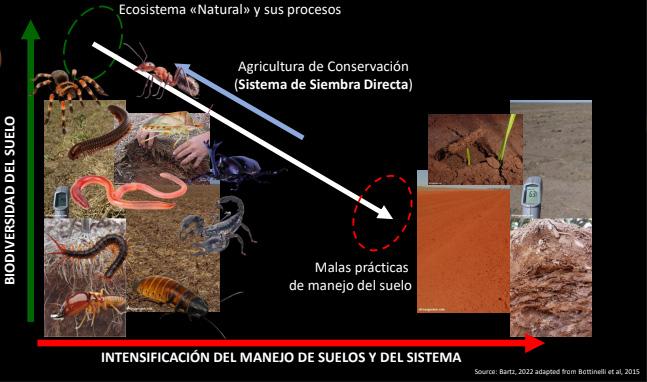
Soil microbiology levels between native vegetation and no-tillage systems are similar. Another assessed indicator was structural quality, which according to the ‘Diagnóstico Estructural Rápido’ can vary from 1 to 6. In the Atlantic Forest, native vegetation reaches values of 6, while notillage systems achieve levels close to 5.


INTA's Natural Resources Program. This program is focused on several axes, including soil, biodiversity, water, air, environmental management, and the use of plant protection products, aiming at maintaining soil productive potential by improving and recovering the different areas.
The program consists of three domestic interrelated projects. The first one addresses the soil's chemical, biological, and physical fertility; the second focuses on greenhouse gas emissions; and the third is related to Carbon sequestration and the capacity to neutralize land degradation. The latter is being assessed on four lines: monitoring soil organic C and land neutrality; experiences to increase soil C sequestration; modeling to estimate potential and different scenarios on how to enhance soil C sinks; and education and training.
Argentina has impressively adopted no-tillage practices, with great potential to rejuvenate soil Carbon. However, this technology should be
accompanied by other management practices, such as rotation intensification and the use of plant amendments, to set a true no-tillage system and express its full potential.
According to a study of domestic SOC levels, Argentine soils store 13.3 billion tons of SOC, representing almost 2% of global C sinks (Figure 2).
According to a study of domestic SOC levels, Argentine soils store 13.3 billion tons of SOC, representing almost 2% of global C sinks.
"There are ways to increase these values, but it is necessary to start incorporating these strategies. It is both a challenge and an opportunity for farmers to use technology, research, and results to generate wealth and foreign currency," Wingeyer concluded.
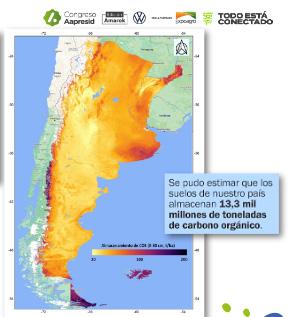

Nutrients are vital for the Soil-Plant-Microbiome system, and their management impacts crop production directly.

The specialists in nutrition, Fernando García from the Faculty of Agricultural Sciences in Balcarce (FCA) and Maria Celina Zabaloy from the Universidad Nacional del Sur (UNS), led a panel about the role of nutrients in the Soil-PlantMicrobiome (SPM) system and their impact on crop production. "Healthy soils generate healthy crops, healthy crops produce healthy food and, ultimately, a healthy humankind and a healthy planet," García claimed (Image 1).


role of nutrients in the Soil-Plant-Microbiome


Pristine environments–the most similar to nature–usually have low food production. In contrast, strictly annual crop systems achieve very high food production, but their similarity to nature is very low. Every time a natural ecosystem is intervened, it affects the cycles, transformations, and flows of the resources involved in that system, including energy flows.
As a result, all ecosystem’s physical, chemical, and biological components are altered. The challenge is to find balance so that the food-producing system is as similar as possible to the natural ecosystem, affecting these cycles and flows as little as possible.
Nutrient cycles vary depending on the nutrient. Nitrogen (N) inputs to the system can come from mineral fertilization, organic compost, biological fixation, and atmospheric deposition. Primary outputs occur through harvesting, but N can also be lost as gas or nitrate due to leaching, runoff, and erosion.
On the other hand, there is Phosphorus (P) and other low-mobility nutrients in the system. In these cases, there is no biological fixation and harvesting losses are similar, but there is less release through other means.
In recent years, nutrient replenishment in the main grain crops in the country through fixation, fertilization, and some organic compost–currently low and with high growth potential–was 60% for N, 64% for P, 1% for K, and approximately 30% for S.
The proposal is to pay attention to current doses of applied N, S, and P and contrast them with the doses that, in theory, should be applied based on each crop's expected yield. This will reveal the current nutrient gap in need of further work.

If we consider the SPM system as a ‘savings account’, it is possible to estimate nutrients balance–taking into account the three means of N loss mentioned above. Consequently, the three primary means of N input and the two primary means of P input are measured, as well as the outputs through the harvesting of each nutrient,

Diagnosis is essential, as the suggested doses of each nutrient are not the same for every environment. Every diagnosis should always begin with a study of the soil.

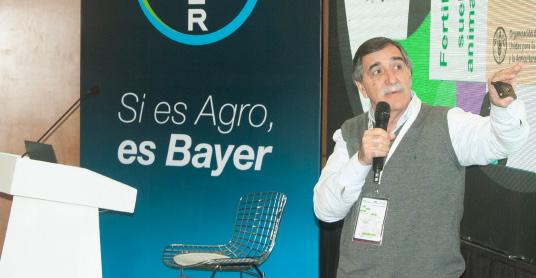
The current challenge is improving the efficiency and effectiveness of systems that apply knowledge and process technology. This entails the integration of multiple N sources, such as recycled, green manures, cover crops, biological, mineral, etc., as well as monitoring and assessing for long-term decision-making.
The specialist concluded that "nutrition is not a separate chapter and there is not only one solution for every situation. It is about evidencebased agriculture. We know it is a complex system, and simplification is not advisable. The truth is that there are many issues, but each issue presents multiple opportunities."
Maria Celina Zabaloy said microorganisms in integral systems are vital and there are no magical solutions. Although bioinputs can originate positive effects in crop yield, these benefits depend on numerous factors, such as the soil, type of crop, and other biotic and abiotic features.
"When bioinputs cause these positive effects in plants, they modify soil microbiome. Success occurs when they establish and colonize the soilplant system in a stable manner," Zabaloy said.
“When
bioinputs cause these positive effects in plants, they modify soil microbiome. Success occurs when they establish and colonize the soil-plant system in a stable manner.”
In semi-arid regions like Southwest Buenos Aires, characterized by a temperate climate and low rainfall, water limitations are imposed on production. Crop sequences are primarily based on wheat and barley, sometimes in rotations with sunflower, but mostly under monocropping conditions. As a consequence, there are long periods of fall-winter fallows, resulting in the underuse of resources like water, nutrients, and radiation, where paradoxically significant water losses due to evaporation occur.

Under adverse climatic conditions, like those experienced in recent years, the region suffered extreme erosion circumstances, with significant losses in the soils' productive capacity. Therefore, it is crucial to acknowledge the importance of maintaining soil coverage.
Cover crops are an available strategy for farmers, enabling constant live vegetation coverage in soils and advancing toward the perpetuation of the system, closely resembling natural ecosystems.
Cover crops in Buenos Aires’s semiarid region
Despite being a region with water limitations for crops, the area employing cover crops presents a significant adoption rate compared to the rest of the country, and it is still growing.
These crops are a good option to increase available N for the subsequent crop and to monitor weeds properly. Moreover, regarding water consumption, they provide good biomass levels to the soil without generating water costs that may compromise the implementation of subsequent cash crops.
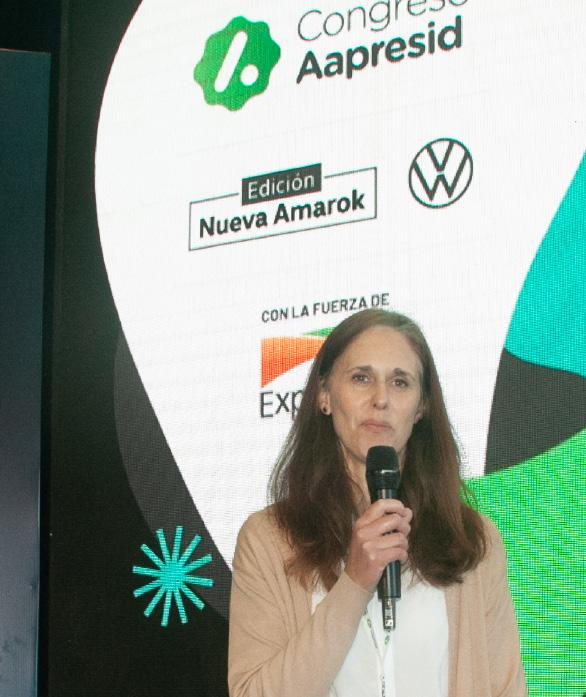
Zabaloy delved into the tests performed with oat as a cover crop, which remained standing from May to October, to the later sunflower cultivation in November, in different plots with and without phosphorus fertilization as a starter. Plots were compared to fallow land circumstances.
At different stages of the sunflower crop, plant growth variables were assessed, and soil rhizosphere samples were taken. Additionally, different termination and nutrition treatments for cover crops were analyzed: rolled cover crop (R), dried cover crop (DQ), rolled cover crop with P fertilization at planting (RP), dried cover crop with P fertilization at planting (DQP), control, and chemical fallow with P fertilization at planting (BP) (Image 2).
Tests showed the positive impacts of cover crops combined with nutrition strategies on the subsequent sunflower crop, observing increments between 12% and 45% in variables like stem and capitulum diameter, weight of the capitulum, and height of the plant in chemicaldried cover crops. This proved that intensification with cover crops favors cash crop development compared to conventional fallow (Image 2)









As regards soil microbiota, results were algo meaningful. A greater fungi richness was observed in the sunflower crop rhizosphere with cover crop as a predecessor. It is commonly known that fungi diversity contributes to crop health and nutrition, particularly arbuscular mycorrhizal fungi, which collaborate in nutrient mobility, combat pathogens in plants, and enhance plant growth.




Mixed systems optimize resources, enhance sustainability, and improve resilience. To achieve these benefits, it is crucial that true integration is reflected in the mindset of farmers and consultants.

Agriculture-livestock integration in mixed systems is a strategy with deep historical roots that has been currently recovering interest. During the 32° edition of the Aapresid Congress "Everything is connected", in the axis "Integrated Systems", Paulo Carvalho, professor at the Federal University of Rio Grande do Sul (UFRGS), and José Jáuregui, professor at the Universidad Nacional del Litoral (UNL), talked about the benefits, challenges, and keys points to efficiently employ mixed systems.
Agriculture and livestock farming specializations have increased in recent years. Production, research, and even academic or postgraduate education have focused their efforts on a single component of the system, without a holistic vision. Although intensification can offer shortterm benefits on efficiency and production,
Paulo Carvalho warned that over-specialization turns establishments into the ‘McDonald's of production systems’, producing commodities with almost identical processes, oriented exclusively toward yield and economic efficiency. Consequently, this leads to standardized production that looks the same anywhere in the world despite different edaphoclimatic conditions. As a result, the loss of diversity and resilience primarily affects the biogeochemical cycles of N and P, intensifying input use.



Carvalho stressed the need to "reverse the trend toward specialization and to restore agriculturelivestock integration as a strategy for optimizing resources and enhancing the sustainability of farming exploitation."
Carvalho said that, according to a study conducted with 944 farmers in Rio Grande do Sul, Brazil, livestock farmers are 39% more likely to adopt integrated systems than growers.
Regardless of the farmer’s primary activity, one of the main challenges is human resources training. Transitioning from a specialized system to an integrated one is not simple, it requires a great change in farmers' mindset and an update in the technical skills of those working in the agricultural sector.
Human resources training also entails the creation of education and training programs
Carvalho has worked on a methodology to promote systemic thinking through farm coaching. This methodology involves meetings and workshops to explore the limits of specialization, deconstruct the current ‘modus operandi’, introduce concepts and tools to understand integration, and generate
experiences to stimulate a new mindset. Hence, co-design a non-compartmentalized production system with systemic management and planning.
Through a serious game, students and farmers plan these more complex systems, combining crops and pastures in rotations, and learning about economic and biological consequences of each method.
As for consultants, there is a high demand for professionals who Carvalho defines as ‘superheroes’. They are expected to have a generalist and broad vision and, at the same time, to properly coordinate the ecosystem's components. Moreover, they should work empathically with the landowners as well as the entire team managing the system.
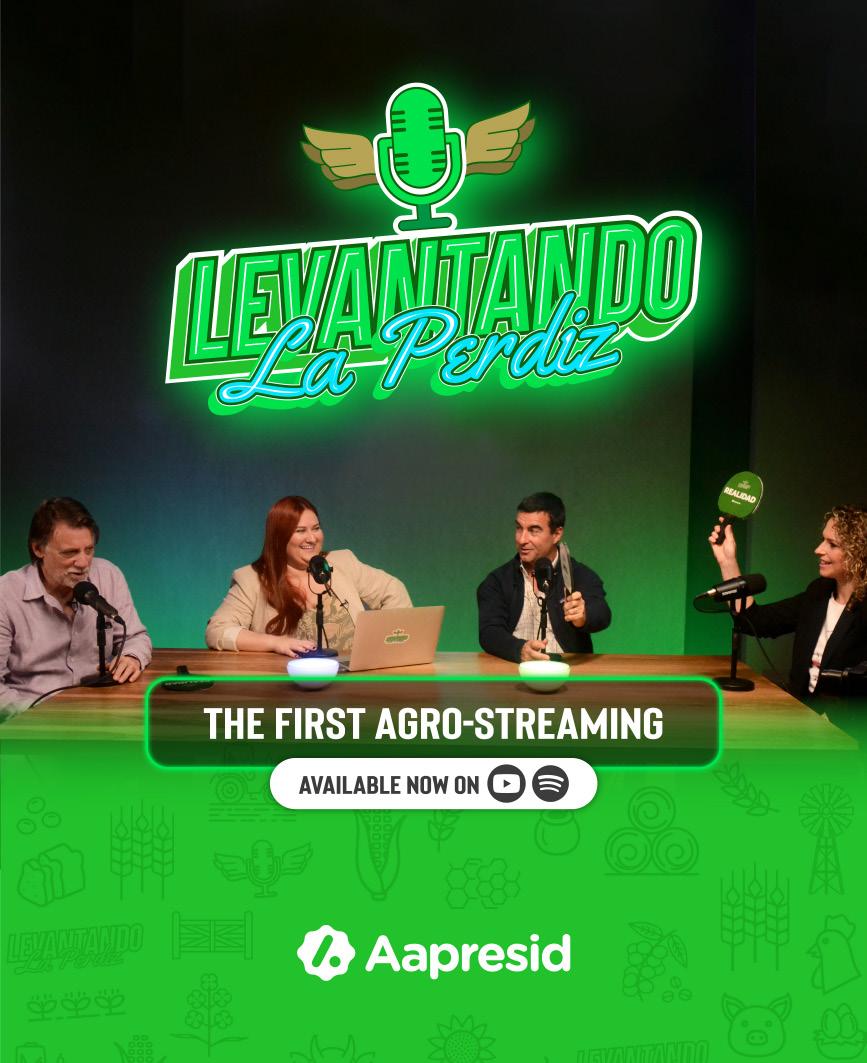
"El Chañar evolved from intensive agricultural production to an integrated model where agriculture and livestock farming work in synergy," José Jáuregui
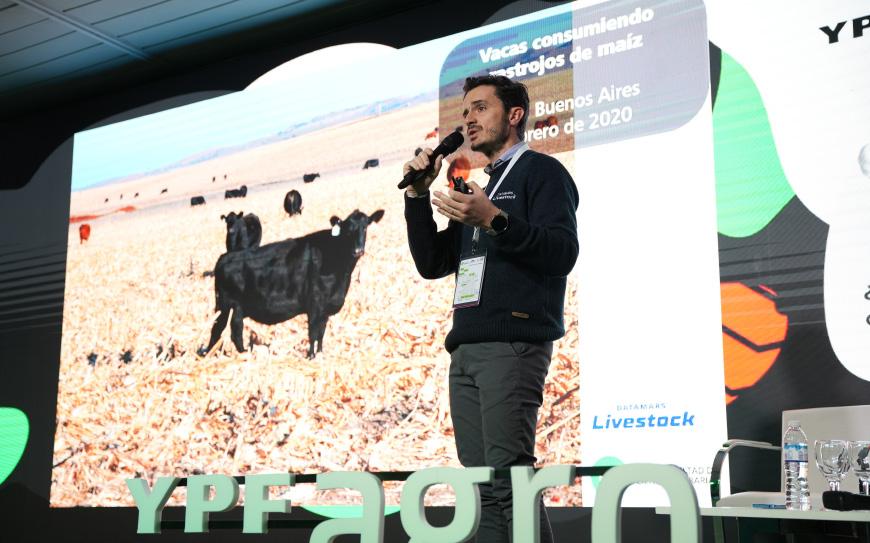
José Jáuregui talked about his experience at Chañar, an establishment located in Noetinger, Córdoba Province, which has successfully implemented a mixed agricultural-livestock system. Over the years, from intensive agricultural production to an integrated model where agriculture and livestock farming work in synergy was neither immediate nor easy; it required a continuous learning process and a series of adjustments in management practices.

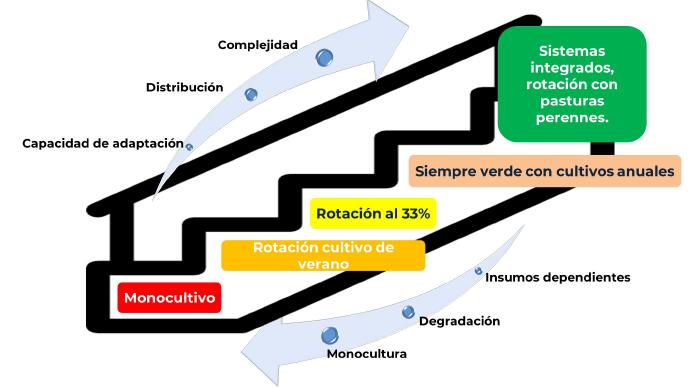
Image 1. Transition from monocropping agriculture to a mixed integrated system.
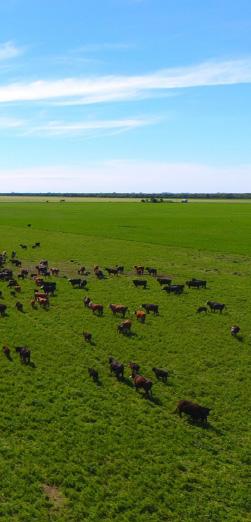

Currently, El Chañar consists of 25% forest from a total of 1291 adjusted hectares. They perform a full cycle, with around 1300 breeding cows in service. In winter, heifers, cull cows, and steers’ diet is pasture-based, with supplementation not exceeding 1% of live weight.
One of the pillars of El Chañar's success is the modification of agricultural crop rotations with pastures, depending on the soil type. In agriculturesuitable plots, alfalfa-based pasture is used 3 out of every 10 years, combined with wheat-second crop soybean, corn, and ryegrass for grazing or firstcrop soybean. In livestock-suitable plots, besides using pastures for three years, they also grow late corn, rescue grass-first crop soybean or sunflower, and then return to pasture.
However, integration does not only rely on rotation. Jáuregui stressed the importance of planning and careful grazing management to avoid overexploitation of forage resources. At
El Chañar, grazing management is based on moderate intensity rotations, where animals move among different plots to enable pasture recovery, which required training for the working team.
This approach has significantly improved forage, soil structure and fertility, reduced the occurrence of pests and diseases, and increased carbon capture.
Moreover, livestock integration has provided an additional source of income and optimized the use of agricultural residues, which are used as feed for cattle. An analysis of over 15 years of gross margin data shows that the agricultural deviation is around 275 dollar/ha, while livestock is 100 dollar/ ha. Although the risk is lower, this figure reflects the complementarity of both activities (Image 2).


Lastly, Jáuregui emphasized the paramount importance of adaptation and flexibility when employing mixed systems. "Each field is different, and what works in certain places may not be suitable for others," he said. Another challenge is to focus on processes rather than inputs
Although transitioning toward a mixed system can be challenging, the long-term benefits are significant. For this integration to be effective, proper training of human resources is essential, both for farmers and technical advisors. They need to see integration as a necessity for the future of agriculture, not just an option.
For this integration to be effective, proper training of human resources is essential, both for farmers and technical advisors. They need to see integration as a necessity for the future of agriculture, not just an option.

Aapresid's Chacra SIPAG promotes agricultural-livestock integration to improve soil health and the sustainability of productive systems. During the Congress, members from Chacra SIPAG explained their approach to facing challenges.

Chacra SIPAG–integrated systems for agriculturallivestock production–is a farm recently incorporated into Aapresid’s Chacras System. The farm is intended to create a development platform that addresses farmers' needs from a system approach and under the essential premise of learning by farming.
In the framework of the Aapresid Congress, the founders of Chacra SIPAG, together with Julio Galli, associate expert at the Faculty of Agricultural Sciences of the UNR, presented the first farm confronting the challenge of integrating agricultural-livestock systems to boost their productive and competitive capacity.
One of the founding members, José Berreta, agricultural-livestock farmer from Buenos Aires, La Pampa, and San Luis provinces, explained that the main target of the farm is to boost different methodologies and ideas based on livestock development that benefits subsequent agriculture.
Chacra SIPAG founders, alongside Julio Galli (UNR-National University of Rosario), showed the challenges faced by Aapresid’s new farm.

Soil health: Located in a semi-arid area, with soils of 85% sand, the farm is facing issues regarding soil structure and organic matter. Consequently, agriculture-livestock rotation based on pastures is seeking to mitigate these problems.
Measurement of key variables: The second step is defining which variables are to be measured at the farm, addressing systems' sustainability. Thus, measures will be based on environmental, social, and economic impact.
Ariel Marino, another funding member and agricultural-livestock farmer from the Guaminí district, joined the project attracted by the potential to integrate different environments across the entire country. Marino said that rotations he has been employing in his system for 47 years share the same principles as the Chacra: agronomically correct systems, economically viable, and socially fair.
Martín Lahitte, also a founding member, agricultural engineer at UNMdP, and manager of agricultural production at Bellamar Estancias SA, explained that, despite environmental diversity at this new farm, everyone shares the same doubts on how to boost sustainability in integrated systems.
Background, purpose, and approach of the project at the Chacra
Fabricio Bongianino, agricultural engineer from the Argentine University of La Pampa and technical manager of development at the Chacra, defined the area of study of the project, which covers a variety of productive environments that combine agriculture and livestock, both breeding and fattening. Despite environmental and scale heterogeneity, everyone is facing the same
issues: productivity drop, yield variability, lack of knowledge about environmental demands in the market, and the imperious need to identify improvement niches
Bongianino said the focus is placed on soil health, pastures incorporation in rotations, service crops grazing, and processes resulting from the interaction between the components that generate synergies in integrated systems.
Julio Galli, professor and researcher of animal production systems at the Faculty of Agricultural Sciences of the UNR, mentioned the great challenge the project represents. He said that the benefits of agriculture-livestock integration go beyond complementing and lie in the synergy processes that occur.
Galli said that the main challenge is achieving a synthesis that explains the behavior of complementation and synergies from a systemic approach, considering environmental and management diversity. This entails analyzing if particular production methods can be useful for different environments, if advantages and disadvantages are manifested in the same way in all establishments, and how to identify emerging properties originating in the system, without relying solely on complementation.
Among the advantages offered by integrated systems, the distinguished ones are nutrient recycling, soil health enhancement, resource use efficiency, greater resilience to climate change, pastures conservation, and income diversification, among others.
Regarding nutrient recycling, these are complex systems with a system within a system, in which livestock, crops, soil, and manure need to be considered. Thus, it is more important to work
The
main challenge is achieving a synthesis that explains the behavior of complementation and synergies from a systemic approach, considering environmental and management diversity on the processes and relationships between elements than on the elements themselves.

To accomplish proper systems integration, it is crucial to combine three types of knowledge: empirical, based on experience; scientific, which explains, predicts and is abstract thinking based on scientific research; and philosophical knowledge, based on how we see difficulties and where we want to go. It also asks two main questions: why do we want to produce? How?

This systemic analysis should be interdisciplinary and address the four approaches: agricultural, livestock, environmental, and social. This interdisciplinary approach creates a model not exactly the same as the real one, meaning that the sum of approaches does not reconstruct the original context. Zooming in on every approach is required, without forgetting the context in which they are located.
Another challenge of the project is determining the scale at which the analysis on integration and diversity in space and time will be conducted. At an establishment level, or plot, parcel, or even large spots? The choice depends on the variable to be measured, as some situations are only considered on very small scales. For instance, there are plots with a certain integration level and others not integrated at all. Meaning they are integrated as complementation but not in time because they always have equal production. That is why two systems presenting the same elements but different diversity levels at different scales are different.
Chacra SIPAG members know that to accomplish the proposed goals, they have to work on a processes-based diagnosis. However, the great question is: How to do it methodologically? Maybe through field tests or simulation models? Specialists agreed that both approaches need further work, taking into account that, currently, there are many theories and knowledge available, and that conducting tests to prove situations already clarified are not necessary. However, there are cases where models are very useful for generating precise questions and finding those areas still lacking information.


































MEDIOS





